History
Greek birth and Roman acquisition

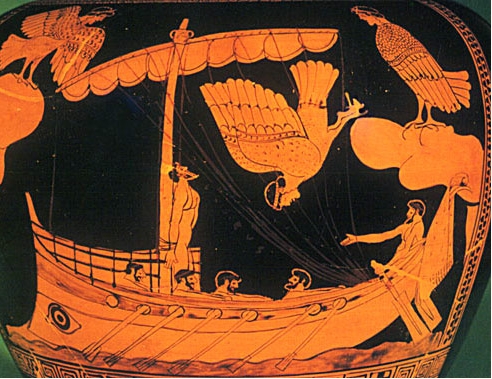
 Naples has been inhabited since the
Naples has been inhabited since the Duchy of Naples
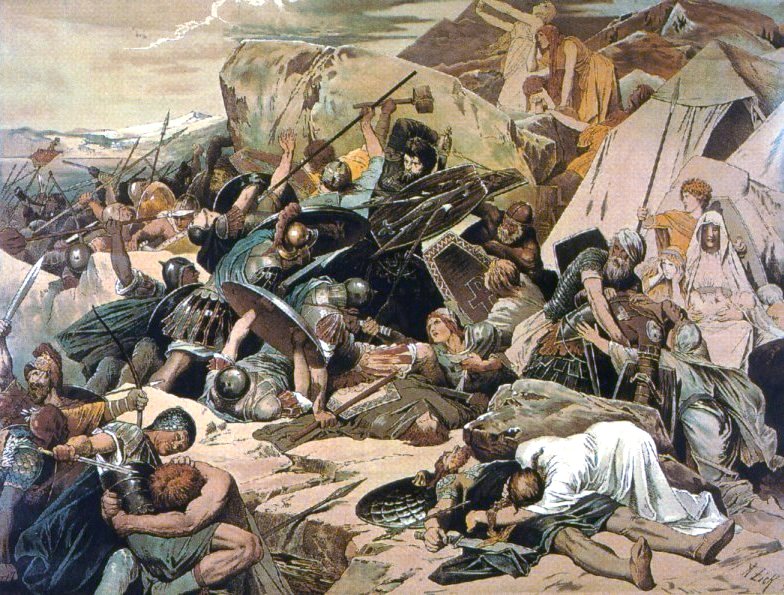 Following the decline of the Western Roman Empire, Naples was captured by the Ostrogoths, a Germanic peoples, Germanic people, and incorporated into the Ostrogothic Kingdom. However, Belisarius of the Byzantine Empire recaptured Naples in 536, after entering the city via an aqueduct.
In 543, during the Gothic War (535–554), Gothic Wars, Totila briefly took the city for the Ostrogoths, but the Byzantines seized control of the area following the Battle of Mons Lactarius on the slopes of Mount Vesuvius, Vesuvius. Naples was expected to keep in contact with the Exarchate of Ravenna, which was the centre of Byzantine power on the Italian Peninsula.
After the exarchate fell, a Duchy of Naples was created. Although Naples' Greco-Roman world, Greco-Roman culture endured, it eventually switched allegiance from Constantinople to Rome under Duke Stephen II of Naples, Stephen II, putting it under Pope, papal suzerainty by 763.
The years between 818 and 832 saw tumultuous relations with the List of Byzantine emperors, Byzantine Emperor, with numerous local pretenders feuding for possession of the ducal throne. Theoctistus of Naples, Theoctistus was appointed without imperial approval; his appointment was later revoked and List of Dukes of Naples, Theodore II took his place. However, the disgruntled general populace chased him from the city and elected Stephen III of Naples, Stephen III instead, a man who minted coins with his initials rather than those of the Byzantine Emperor. Naples gained complete independence by the early ninth century. Naples allied with the Muslim Saracens in 836 and asked for their support to repel the siege of Lombards, Lombard troops coming from the neighbouring Duchy of Benevento. However, during the 850s, Muhammad I Abu 'l-Abbas led the Arab-Muslim to sack the city.
The duchy was under the direct control of the Lombards for a brief period after the capture by Pandulf IV of Capua, Pandulf IV of the Principality of Capua, a long-term rival of Naples; however, this regime lasted only three years before the Greco-Roman-influenced dukes were reinstated. By the 11th century, Naples had begun to employ Normans, Norman mercenaries to battle their rivals; Duke Sergius IV of Naples, Sergius IV hired Rainulf Drengot to wage war on Capua for him.
By 1137, the Normans had attained great influence in Italy, controlling previously independent principalities and duchies such as Principality of Capua, Capua, Duchy of Benevento, Benevento, Principality of Salerno, Salerno, Duchy of Amalfi, Amalfi, Duchy of Sorrento, Sorrento and Duchy of Gaeta, Gaeta; it was in this year that Naples, the last independent duchy in the southern part of the peninsula, came under Norman control. The last ruling duke of the duchy, Sergius VII of Naples, Sergius VII, was forced to surrender to Roger II of Sicily, Roger II, who had been proclaimed List of monarchs of Sicily, King of Sicily by Antipope Anacletus II seven years earlier. Naples thus joined the Kingdom of Sicily, with Palermo as the capital.
Following the decline of the Western Roman Empire, Naples was captured by the Ostrogoths, a Germanic peoples, Germanic people, and incorporated into the Ostrogothic Kingdom. However, Belisarius of the Byzantine Empire recaptured Naples in 536, after entering the city via an aqueduct.
In 543, during the Gothic War (535–554), Gothic Wars, Totila briefly took the city for the Ostrogoths, but the Byzantines seized control of the area following the Battle of Mons Lactarius on the slopes of Mount Vesuvius, Vesuvius. Naples was expected to keep in contact with the Exarchate of Ravenna, which was the centre of Byzantine power on the Italian Peninsula.
After the exarchate fell, a Duchy of Naples was created. Although Naples' Greco-Roman world, Greco-Roman culture endured, it eventually switched allegiance from Constantinople to Rome under Duke Stephen II of Naples, Stephen II, putting it under Pope, papal suzerainty by 763.
The years between 818 and 832 saw tumultuous relations with the List of Byzantine emperors, Byzantine Emperor, with numerous local pretenders feuding for possession of the ducal throne. Theoctistus of Naples, Theoctistus was appointed without imperial approval; his appointment was later revoked and List of Dukes of Naples, Theodore II took his place. However, the disgruntled general populace chased him from the city and elected Stephen III of Naples, Stephen III instead, a man who minted coins with his initials rather than those of the Byzantine Emperor. Naples gained complete independence by the early ninth century. Naples allied with the Muslim Saracens in 836 and asked for their support to repel the siege of Lombards, Lombard troops coming from the neighbouring Duchy of Benevento. However, during the 850s, Muhammad I Abu 'l-Abbas led the Arab-Muslim to sack the city.
The duchy was under the direct control of the Lombards for a brief period after the capture by Pandulf IV of Capua, Pandulf IV of the Principality of Capua, a long-term rival of Naples; however, this regime lasted only three years before the Greco-Roman-influenced dukes were reinstated. By the 11th century, Naples had begun to employ Normans, Norman mercenaries to battle their rivals; Duke Sergius IV of Naples, Sergius IV hired Rainulf Drengot to wage war on Capua for him.
By 1137, the Normans had attained great influence in Italy, controlling previously independent principalities and duchies such as Principality of Capua, Capua, Duchy of Benevento, Benevento, Principality of Salerno, Salerno, Duchy of Amalfi, Amalfi, Duchy of Sorrento, Sorrento and Duchy of Gaeta, Gaeta; it was in this year that Naples, the last independent duchy in the southern part of the peninsula, came under Norman control. The last ruling duke of the duchy, Sergius VII of Naples, Sergius VII, was forced to surrender to Roger II of Sicily, Roger II, who had been proclaimed List of monarchs of Sicily, King of Sicily by Antipope Anacletus II seven years earlier. Naples thus joined the Kingdom of Sicily, with Palermo as the capital.
As part of the Kingdom of Sicily
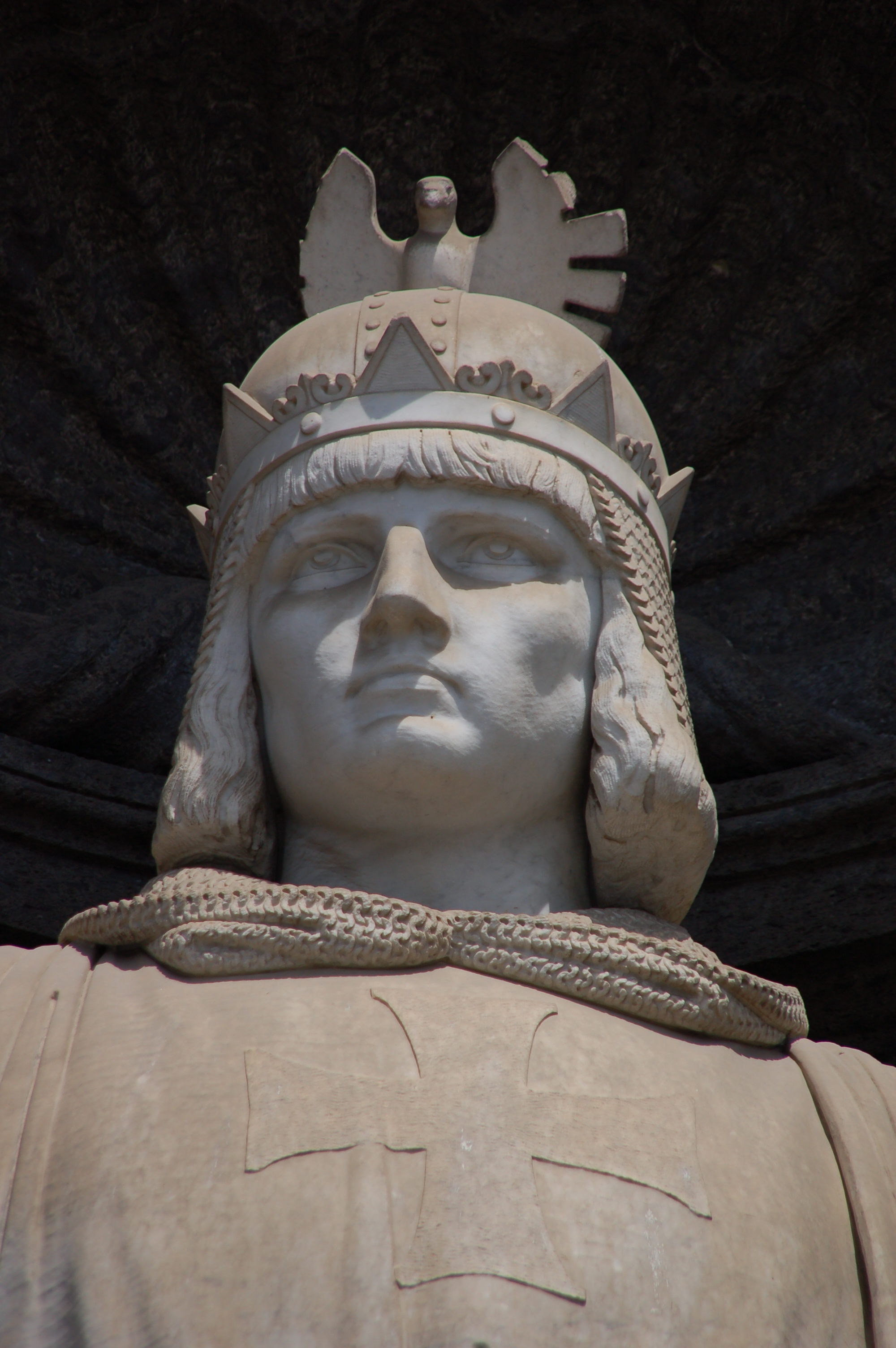 After a period of Norman rule, in 1189 the Kingdom of Sicily was in a succession dispute between Tancred, King of Sicily of an illegitimate birth and the House of Hohenstaufen, Hohenstaufens, a Germanic dynasty, royal house, as its Prince Henry had married Constance, Queen of Sicily, Princess Constance the last legitimate heir to the Sicilian throne. In 1191 Henry invaded Sicily after being crowned as Henry VI, Holy Roman Emperor, and many cities surrendered. Still, Naples resisted him from May to August under the leadership of Richard, Count of Acerra, Nicholas of Ajello, Aligerno Cottone and Margaritus of Brindisi before the Germans suffered from disease and were forced to retreat. Conrad II, Duke of Bohemia and Philip I, Archbishop of Cologne died of disease during Siege of Naples (1191), the siege. During his counterattack, Tancred captured Constance, now empress. He had the empress imprisoned at Castel dell'Ovo at Naples before her release on May 1192 under the pressure of Pope Celestine III. In 1194 Henry started his second campaign upon the death of Tancred, but this time Aligerno surrendered without resistance, and finally, Henry conquered Sicily, putting it under the rule of Hohenstaufens.
The University of Naples Federico II, University of Naples, the first university in Europe dedicated to training secular administrators, was founded by Frederick II, Holy Roman Emperor, Frederick II, making Naples the intellectual centre of the kingdom. Conflict between the Hohenstaufens and the Pope, Papacy led in 1266 to Pope Innocent IV crowning the Capetian House of Anjou, Angevin duke Charles I of Naples, Charles I King of Sicily: Charles officially moved the capital from Palermo to Naples, where he resided at the Castel Nuovo. Having a great interest in architecture, Charles I imported French architects and workmen and was personally involved in several building projects in the city. Many examples of Gothic architecture sprang up around Naples, including the Naples Cathedral, which remains the city's main church.
After a period of Norman rule, in 1189 the Kingdom of Sicily was in a succession dispute between Tancred, King of Sicily of an illegitimate birth and the House of Hohenstaufen, Hohenstaufens, a Germanic dynasty, royal house, as its Prince Henry had married Constance, Queen of Sicily, Princess Constance the last legitimate heir to the Sicilian throne. In 1191 Henry invaded Sicily after being crowned as Henry VI, Holy Roman Emperor, and many cities surrendered. Still, Naples resisted him from May to August under the leadership of Richard, Count of Acerra, Nicholas of Ajello, Aligerno Cottone and Margaritus of Brindisi before the Germans suffered from disease and were forced to retreat. Conrad II, Duke of Bohemia and Philip I, Archbishop of Cologne died of disease during Siege of Naples (1191), the siege. During his counterattack, Tancred captured Constance, now empress. He had the empress imprisoned at Castel dell'Ovo at Naples before her release on May 1192 under the pressure of Pope Celestine III. In 1194 Henry started his second campaign upon the death of Tancred, but this time Aligerno surrendered without resistance, and finally, Henry conquered Sicily, putting it under the rule of Hohenstaufens.
The University of Naples Federico II, University of Naples, the first university in Europe dedicated to training secular administrators, was founded by Frederick II, Holy Roman Emperor, Frederick II, making Naples the intellectual centre of the kingdom. Conflict between the Hohenstaufens and the Pope, Papacy led in 1266 to Pope Innocent IV crowning the Capetian House of Anjou, Angevin duke Charles I of Naples, Charles I King of Sicily: Charles officially moved the capital from Palermo to Naples, where he resided at the Castel Nuovo. Having a great interest in architecture, Charles I imported French architects and workmen and was personally involved in several building projects in the city. Many examples of Gothic architecture sprang up around Naples, including the Naples Cathedral, which remains the city's main church.
Kingdom of Naples
Aragonese and Spanish
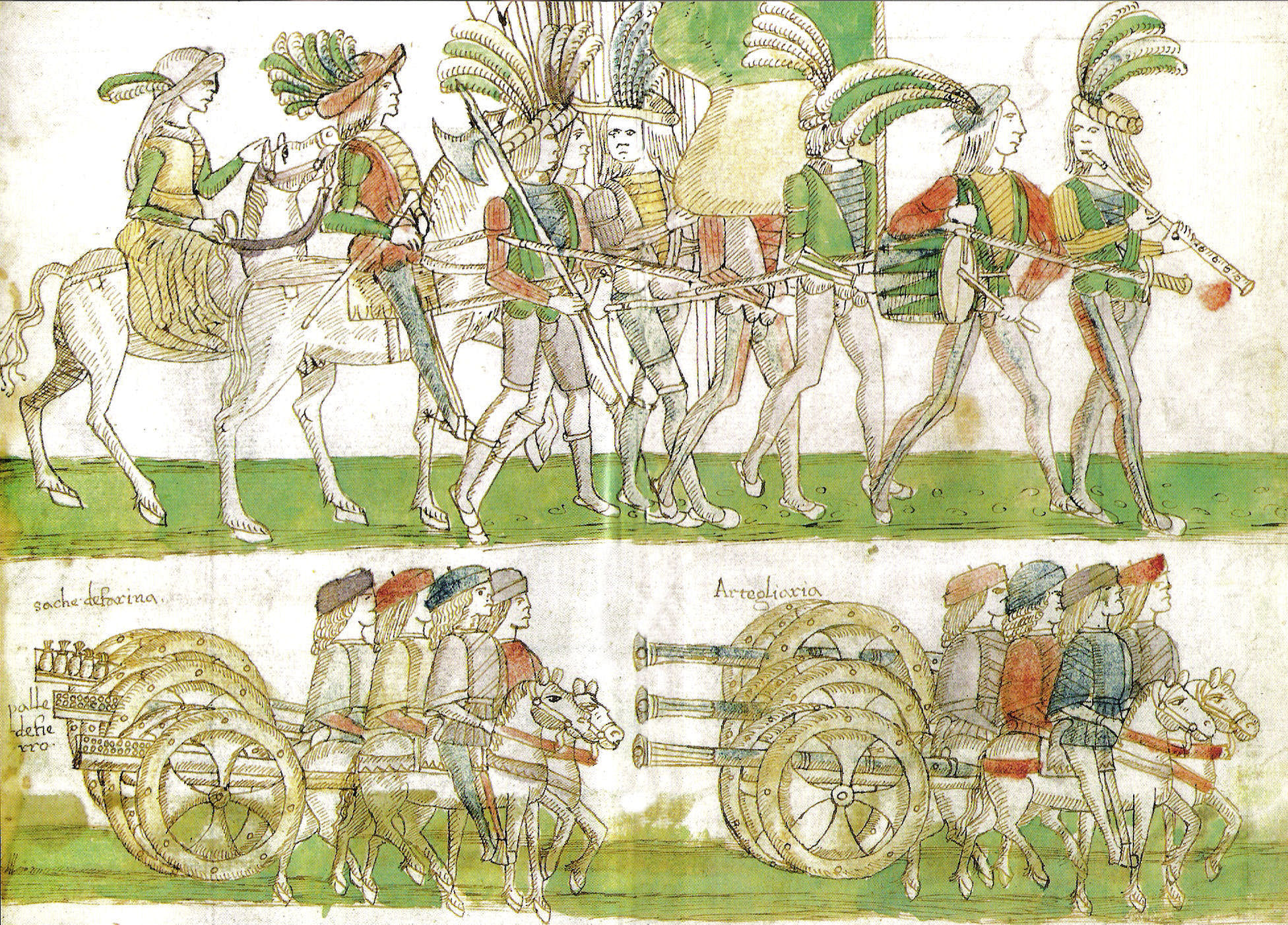 Sicily and Naples were separated since 1282, but remained dependencies of Crown of Aragon, Aragon under Ferdinand I of Naples, Ferdinand I. The new dynasty enhanced Naples' commercial standing by establishing relations with the Iberian Peninsula. Naples also became a centre of the Renaissance, with artists such as Francesco Laurana, Laurana, Antonello da Messina, da Messina, Jacopo Sannazaro, Sannazzaro and Poliziano arriving in the city. In 1501, Naples came under direct rule from Ancien Régime in France, France under Louis XII of France, Louis XII, with the Neapolitan king Frederick IV of Naples, Frederick being taken as a prisoner to France; however, this state of affairs did not last long, as Spain won Naples from the French at the Battle of Garigliano (1503), Battle of Garigliano in 1503.
Sicily and Naples were separated since 1282, but remained dependencies of Crown of Aragon, Aragon under Ferdinand I of Naples, Ferdinand I. The new dynasty enhanced Naples' commercial standing by establishing relations with the Iberian Peninsula. Naples also became a centre of the Renaissance, with artists such as Francesco Laurana, Laurana, Antonello da Messina, da Messina, Jacopo Sannazaro, Sannazzaro and Poliziano arriving in the city. In 1501, Naples came under direct rule from Ancien Régime in France, France under Louis XII of France, Louis XII, with the Neapolitan king Frederick IV of Naples, Frederick being taken as a prisoner to France; however, this state of affairs did not last long, as Spain won Naples from the French at the Battle of Garigliano (1503), Battle of Garigliano in 1503.
 Following the Spanish victory, Naples became part of the Spanish Empire, and remained so throughout the Habsburg Spain, Spanish Habsburg period. The Spanish sent viceroys List of viceroys of Naples, to Naples to directly deal with local issues: the most important of these viceroys was Pedro Álvarez de Toledo, Marquis of Villafranca, Pedro Álvarez de Toledo, who was responsible for considerable social, economic and urban reforms in the city; he also tried to introduce the Spanish Inquisition, Inquisition. In 1544, around 7,000 people were taken as Barbary slave trade, slaves by Barbary pirates and brought to the Barbary Coast of North Africa (see Sack of Naples).
By the 17th century, Naples had become Europe's second-largest city – second only to Paris – and the largest European Mediterranean city, with around 250,000 inhabitants. The city was a major cultural centre during the Baroque era, being home to artists such as Caravaggio, Salvator Rosa and Gian Lorenzo Bernini, Bernini, philosophers such as Bernardino Telesio, Giordano Bruno, Tommaso Campanella and Giambattista Vico, and writers such as Giambattista Marino. A revolution led by the local fisherman Masaniello saw the creation of a brief independent Neapolitan Republic (1647), Neapolitan Republic in 1647. However, this lasted only a few months before Spanish rule was reasserted. In 1656, an outbreak of Naples Plague, bubonic plague killed about half of Naples' 300,000 inhabitants.
Following the Spanish victory, Naples became part of the Spanish Empire, and remained so throughout the Habsburg Spain, Spanish Habsburg period. The Spanish sent viceroys List of viceroys of Naples, to Naples to directly deal with local issues: the most important of these viceroys was Pedro Álvarez de Toledo, Marquis of Villafranca, Pedro Álvarez de Toledo, who was responsible for considerable social, economic and urban reforms in the city; he also tried to introduce the Spanish Inquisition, Inquisition. In 1544, around 7,000 people were taken as Barbary slave trade, slaves by Barbary pirates and brought to the Barbary Coast of North Africa (see Sack of Naples).
By the 17th century, Naples had become Europe's second-largest city – second only to Paris – and the largest European Mediterranean city, with around 250,000 inhabitants. The city was a major cultural centre during the Baroque era, being home to artists such as Caravaggio, Salvator Rosa and Gian Lorenzo Bernini, Bernini, philosophers such as Bernardino Telesio, Giordano Bruno, Tommaso Campanella and Giambattista Vico, and writers such as Giambattista Marino. A revolution led by the local fisherman Masaniello saw the creation of a brief independent Neapolitan Republic (1647), Neapolitan Republic in 1647. However, this lasted only a few months before Spanish rule was reasserted. In 1656, an outbreak of Naples Plague, bubonic plague killed about half of Naples' 300,000 inhabitants.
 In 1714, Spanish rule over Naples came to an end as a result of the War of the Spanish Succession; the Austrian Charles VI, Holy Roman Emperor, Charles VI ruled the city from Vienna through viceroys of his own. However, the War of the Polish Succession saw the Spanish regain Sicily and Naples as part of a personal union, with the 1738 Treaty of Vienna (1738), Treaty of Vienna recognising the two polities as independent under a cadet branch of the Spanish House of Bourbon, Bourbons.
In 1755, the Duke of Noja commissioned an accurate topographic map of Naples, later known as the Map of the Duke of Nojo, employing rigorous surveying accuracy and becoming an essential urban planning tool for Naples.
During the time of Ferdinand I of the Two Sicilies, Ferdinand IV, the effects of the French Revolution were felt in Naples: Horatio Nelson, 1st Viscount Nelson, Horatio Nelson, an ally of the Bourbons, arrived in the city in 1798 to warn against the French republicans. Ferdinand was forced to retreat and fled to Palermo, where he was protected by a Royal Navy, British fleet. However, Naples' Social class, lower class ''Naples Lazzaroni, lazzaroni'' were strongly Piety, pious and Monarchism, royalist, favouring the Bourbons; in the mêlée that followed, they fought the Neapolitan pro-Italy, Republican aristocracy, causing a civil war.
In 1714, Spanish rule over Naples came to an end as a result of the War of the Spanish Succession; the Austrian Charles VI, Holy Roman Emperor, Charles VI ruled the city from Vienna through viceroys of his own. However, the War of the Polish Succession saw the Spanish regain Sicily and Naples as part of a personal union, with the 1738 Treaty of Vienna (1738), Treaty of Vienna recognising the two polities as independent under a cadet branch of the Spanish House of Bourbon, Bourbons.
In 1755, the Duke of Noja commissioned an accurate topographic map of Naples, later known as the Map of the Duke of Nojo, employing rigorous surveying accuracy and becoming an essential urban planning tool for Naples.
During the time of Ferdinand I of the Two Sicilies, Ferdinand IV, the effects of the French Revolution were felt in Naples: Horatio Nelson, 1st Viscount Nelson, Horatio Nelson, an ally of the Bourbons, arrived in the city in 1798 to warn against the French republicans. Ferdinand was forced to retreat and fled to Palermo, where he was protected by a Royal Navy, British fleet. However, Naples' Social class, lower class ''Naples Lazzaroni, lazzaroni'' were strongly Piety, pious and Monarchism, royalist, favouring the Bourbons; in the mêlée that followed, they fought the Neapolitan pro-Italy, Republican aristocracy, causing a civil war.
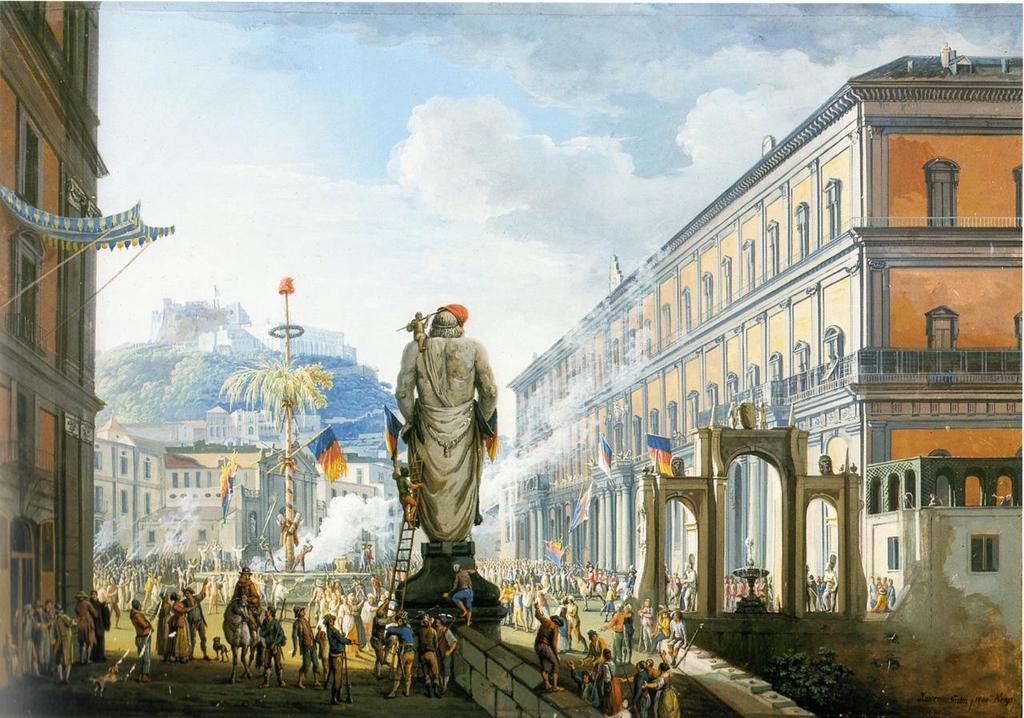 Eventually, the Republicans conquered Castel Sant'Elmo and proclaimed a Parthenopaean Republic, secured by the French Army. A counter-revolutionary religious army of ''lazzaroni'' known as the ''sanfedismo, sanfedisti'' under Cardinal Fabrizio Ruffo was raised; they met with great success, and the French were forced to surrender the Neapolitan castles, with their fleet sailing back to Toulon.
Ferdinand IV was restored as king; however, after only seven years, Napoleon I of France, Napoleon conquered the kingdom and installed House of Bonaparte, Bonapartist kings, including his brother Joseph Bonaparte (King of Spain). With the help of the Austrian Empire and its allies, the Bonapartists were defeated in the Neapolitan War. Ferdinand IV once again regained the throne and the kingdom.
Eventually, the Republicans conquered Castel Sant'Elmo and proclaimed a Parthenopaean Republic, secured by the French Army. A counter-revolutionary religious army of ''lazzaroni'' known as the ''sanfedismo, sanfedisti'' under Cardinal Fabrizio Ruffo was raised; they met with great success, and the French were forced to surrender the Neapolitan castles, with their fleet sailing back to Toulon.
Ferdinand IV was restored as king; however, after only seven years, Napoleon I of France, Napoleon conquered the kingdom and installed House of Bonaparte, Bonapartist kings, including his brother Joseph Bonaparte (King of Spain). With the help of the Austrian Empire and its allies, the Bonapartists were defeated in the Neapolitan War. Ferdinand IV once again regained the throne and the kingdom.
Independent Two Sicilies
The Congress of Vienna in 1815 saw the kingdoms of Naples and Sicily combine to form the Kingdom of the Two Sicilies, with Naples as the capital city. In 1839, Naples became the first city on the Italian peninsula to have a railway, with the construction of the Naples–Portici railway line, Naples–Portici railway.Italian unification to the present day
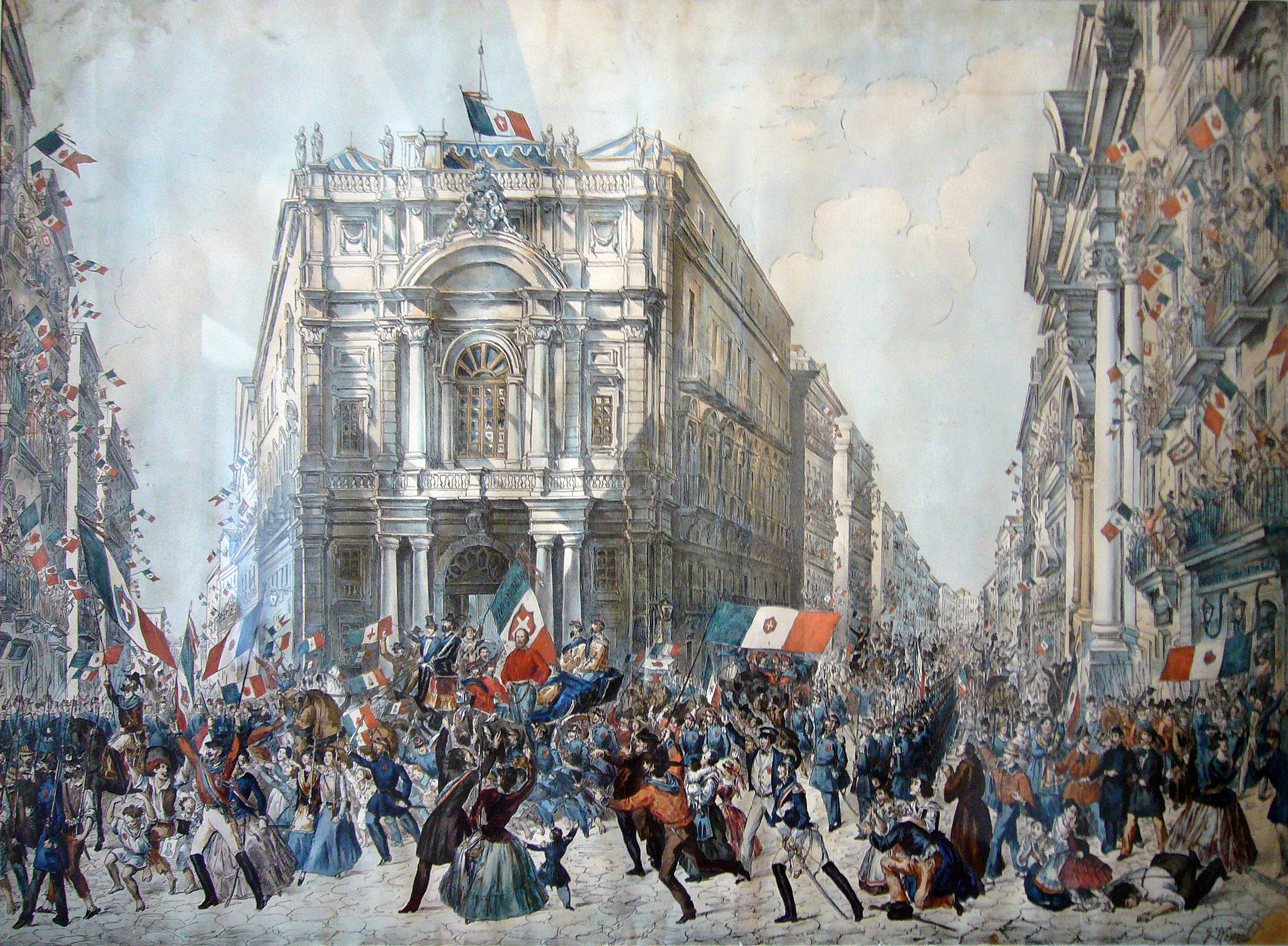 After the Expedition of the Thousand led by Giuseppe Garibaldi, which culminated in the controversial Siege of Gaeta (1860), Siege of Gaeta, Naples became part of the Kingdom of Italy in 1861 as part of the Italian unification, ending the era of Bourbon rule. The economy of the area formerly known as the Two Sicilies declined, leading to an unprecedented Italian diaspora, wave of emigration, with an estimated 4 million people emigrating from the Naples area between 1876 and 1913. In the forty years following unification, the population of Naples grew by only 26%, vs. 63% for Turin and 103% for Milan; however, by 1884, Naples was still the largest city in Italy with 496,499 inhabitants, or roughly 64,000 per square kilometre (more than twice the population density of Paris).
Public health conditions in certain areas of the city were poor, with twelve epidemics of cholera and typhoid fever claiming some 48,000 people between 1834 and 1884. A death rate 31.84 per thousand, high even for the time, insisted in the absence of epidemics between 1878 and 1883. Then in 1884, Naples fell victim to a major cholera epidemic, caused largely by the city's poor sewerage infrastructure. In response to these problems, in 1852, the government prompted a radical transformation of the city called ''risanamento'' to improve the sewerage infrastructure and replace the most clustered areas, considered the main cause of insalubrity, with large and airy avenues. The project proved difficult to accomplish politically and economically due to corruption, as shown in the Saredo Inquiry, land speculation and extremely long bureaucracy. This led to the project to massive delays with contrasting results. The most notable transformations made were the construction of Via Caracciolo in place of the beach along the promenade, the creation of Galleria Umberto I and c:Galleria Principe di Napoli (Naples), Galleria Principe and the construction of Corso Umberto.
After the Expedition of the Thousand led by Giuseppe Garibaldi, which culminated in the controversial Siege of Gaeta (1860), Siege of Gaeta, Naples became part of the Kingdom of Italy in 1861 as part of the Italian unification, ending the era of Bourbon rule. The economy of the area formerly known as the Two Sicilies declined, leading to an unprecedented Italian diaspora, wave of emigration, with an estimated 4 million people emigrating from the Naples area between 1876 and 1913. In the forty years following unification, the population of Naples grew by only 26%, vs. 63% for Turin and 103% for Milan; however, by 1884, Naples was still the largest city in Italy with 496,499 inhabitants, or roughly 64,000 per square kilometre (more than twice the population density of Paris).
Public health conditions in certain areas of the city were poor, with twelve epidemics of cholera and typhoid fever claiming some 48,000 people between 1834 and 1884. A death rate 31.84 per thousand, high even for the time, insisted in the absence of epidemics between 1878 and 1883. Then in 1884, Naples fell victim to a major cholera epidemic, caused largely by the city's poor sewerage infrastructure. In response to these problems, in 1852, the government prompted a radical transformation of the city called ''risanamento'' to improve the sewerage infrastructure and replace the most clustered areas, considered the main cause of insalubrity, with large and airy avenues. The project proved difficult to accomplish politically and economically due to corruption, as shown in the Saredo Inquiry, land speculation and extremely long bureaucracy. This led to the project to massive delays with contrasting results. The most notable transformations made were the construction of Via Caracciolo in place of the beach along the promenade, the creation of Galleria Umberto I and c:Galleria Principe di Napoli (Naples), Galleria Principe and the construction of Corso Umberto.
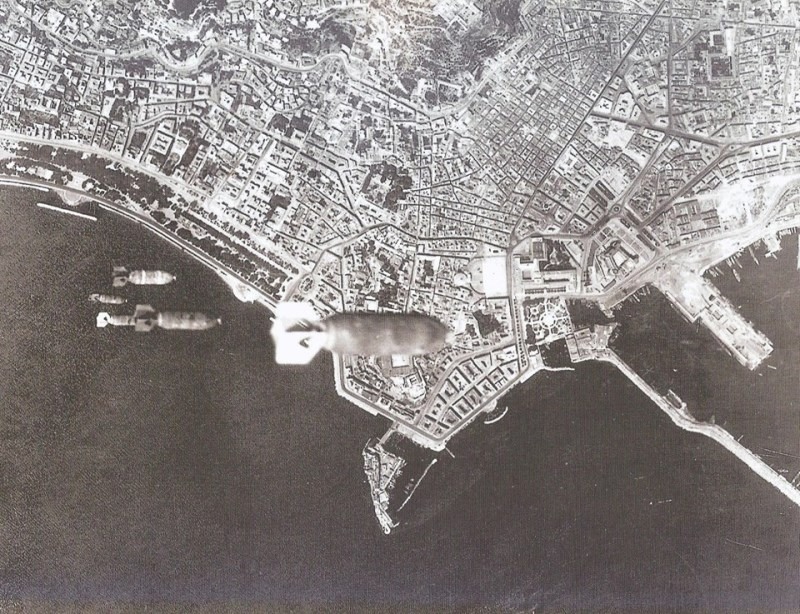 Naples was the Bombing of Naples in World War II, most-bombed Italian city during
Naples was the Bombing of Naples in World War II, most-bombed Italian city during . ''Il Mattino''. 20 June 2012. Retrieved 11 July 2012.
. ''Il Mattino di Padova''. 21 June 2012. Retrieved 14 July 2012. Naples hosted the sixth World Urban Forum in September 2012 and the 63rd International Astronautical Congress in October 2012. In 2013, it was the host of the Universal Forum of Cultures and the host for the 2019 Summer Universiade.
Architecture
UNESCO World Heritage Site
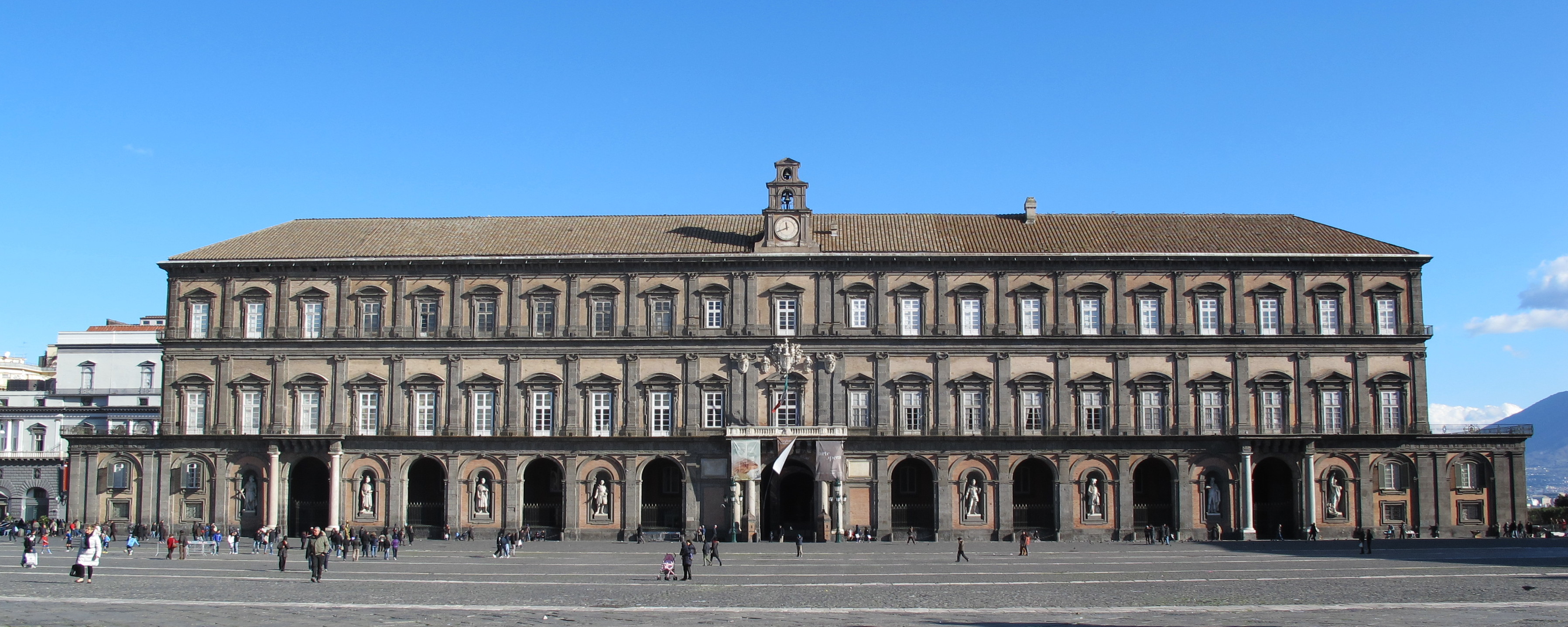 Naples' 2,800-year history has left it with a wealth of historical buildings and monuments, from medieval castles to classical ruins, and a wide range of culturally and historically significant sites nearby, including the
Naples' 2,800-year history has left it with a wealth of historical buildings and monuments, from medieval castles to classical ruins, and a wide range of culturally and historically significant sites nearby, including the Piazzas, palaces and castles
 The main city square or ''piazza'' of the city is the Piazza del Plebiscito. Its construction was begun by the Bonapartist king Joachim Murat and finished by the Bourbon king Ferdinand I of the Two Sicilies, Ferdinand IV. The piazza is bounded on the east by the Royal Palace (Naples), Royal Palace and on the west by the church of San Francesco di Paola (Naples), San Francesco di Paola, with the colonnades extending on both sides. Nearby is the Teatro di San Carlo, which is the oldest opera house in Italy. Directly across San Carlo is Galleria Umberto I, Galleria Umberto.
Naples is well known for its castles: The most ancient is Castel dell'Ovo ("Egg Castle"), which was built on the tiny islet of Megarides, where the original Cumaean colonists had founded the city. In Roman times the islet became part of Lucullus's villa, later hosting Romulus Augustulus, the exiled last western Roman emperor. It had also been the prison for Constance, Queen of Sicily, Empress Constance between 1191 and 1192 after her being captured by Sicilians, and Conradin and Giovanna I of Naples before their executions.
Castel Nuovo, also known as ''Maschio Capetian House of Anjou, Angioino'', is one of the city's top landmarks; it was built during the time of Charles I of Naples, Charles I, the first List of monarchs of Naples, king of Naples. Castel Nuovo has seen many notable historical events: for example, in 1294, Pope Celestine V resigned as pope in a hall of the castle, and following this Pope Boniface VIII was elected pope by the cardinal Collegium (ancient Rome), collegium, before moving to Rome.
Castel Capuano was built in the 12th century by William I of Sicily, William I, the son of Roger II of Sicily, the first monarch of the Kingdom of Naples. It was expanded by Frederick II, Holy Roman Emperor, Frederick II and became one of his royal palaces. The castle was the residence of many kings and queens throughout its history. In the 16th century, it became the Hall of Justice.
Another Neapolitan castle is Castel Sant'Elmo, which was completed in 1329 and is built in the shape of a star. Its strategic position overlooking the entire city made it a target of various invaders. During the uprising of Masaniello in 1647, the Spanish took refuge in Sant'Elmo to escape the revolutionaries.
The Carmine Castle, built in 1392 and highly modified in the 16th century by the Spanish, was demolished in 1906 to make room for the Via Marina, although two of the castle's towers remain as a monument. The Vigliena Fort, built in 1702, was destroyed in 1799 during the royalist war against the Parthenopean Republic and is now abandoned and in ruin.
The main city square or ''piazza'' of the city is the Piazza del Plebiscito. Its construction was begun by the Bonapartist king Joachim Murat and finished by the Bourbon king Ferdinand I of the Two Sicilies, Ferdinand IV. The piazza is bounded on the east by the Royal Palace (Naples), Royal Palace and on the west by the church of San Francesco di Paola (Naples), San Francesco di Paola, with the colonnades extending on both sides. Nearby is the Teatro di San Carlo, which is the oldest opera house in Italy. Directly across San Carlo is Galleria Umberto I, Galleria Umberto.
Naples is well known for its castles: The most ancient is Castel dell'Ovo ("Egg Castle"), which was built on the tiny islet of Megarides, where the original Cumaean colonists had founded the city. In Roman times the islet became part of Lucullus's villa, later hosting Romulus Augustulus, the exiled last western Roman emperor. It had also been the prison for Constance, Queen of Sicily, Empress Constance between 1191 and 1192 after her being captured by Sicilians, and Conradin and Giovanna I of Naples before their executions.
Castel Nuovo, also known as ''Maschio Capetian House of Anjou, Angioino'', is one of the city's top landmarks; it was built during the time of Charles I of Naples, Charles I, the first List of monarchs of Naples, king of Naples. Castel Nuovo has seen many notable historical events: for example, in 1294, Pope Celestine V resigned as pope in a hall of the castle, and following this Pope Boniface VIII was elected pope by the cardinal Collegium (ancient Rome), collegium, before moving to Rome.
Castel Capuano was built in the 12th century by William I of Sicily, William I, the son of Roger II of Sicily, the first monarch of the Kingdom of Naples. It was expanded by Frederick II, Holy Roman Emperor, Frederick II and became one of his royal palaces. The castle was the residence of many kings and queens throughout its history. In the 16th century, it became the Hall of Justice.
Another Neapolitan castle is Castel Sant'Elmo, which was completed in 1329 and is built in the shape of a star. Its strategic position overlooking the entire city made it a target of various invaders. During the uprising of Masaniello in 1647, the Spanish took refuge in Sant'Elmo to escape the revolutionaries.
The Carmine Castle, built in 1392 and highly modified in the 16th century by the Spanish, was demolished in 1906 to make room for the Via Marina, although two of the castle's towers remain as a monument. The Vigliena Fort, built in 1702, was destroyed in 1799 during the royalist war against the Parthenopean Republic and is now abandoned and in ruin.
Museums

 Naples is widely known for its wealth of historical museums. The Naples National Archaeological Museum is one of the city's main museums, with one of the most extensive collections of artifact (archaeology), artefacts of the Roman Empire in the world. It also houses many of the antiques unearthed at Pompeii and Herculaneum, as well as some artefacts from the Magna Graecia, Greek and Italian Renaissance, Renaissance periods.
Previously a Bourbon palace, now a museum and art gallery, the Museo di Capodimonte is another museum of note. The List of works in the Galleria Nazionale di Capodimonte, gallery features paintings from the 13th to the 18th centuries, including major works by Simone Martini, Raphael, Titian, Caravaggio, El Greco, Jusepe de Ribera and Luca Giordano. The royal apartments are furnished with antique 18th-century furniture and a collection of porcelain and Victorian majolica, majolica from the various royal residences: the famous Capodimonte porcelain, Capodimonte Porcelain Factory once stood just adjacent to the palace.
In front of the Royal Palace of Naples stands the Galleria Umberto I, which contains the Coral Jewellery Museum. Occupying a 19th-century palazzo renovated by the Portuguese architect Álvaro Siza, the Museo d'Arte Contemporanea Donnaregina (MADRE) features an enfilade procession of permanent installations by artists such as Francesco Clemente, Richard Serra, and Rebecca Horn. The 16th-century palace of Roccella hosts the Palazzo delle Arti Napoli, which contains the civic collections of art belonging to the City of Naples, and features temporary exhibits of art and culture. Palazzo Como, which dates from the 15th century, hosts the Museo Filangieri of plastic arts, created in 1883 by Gaetano Filangieri.
Naples is widely known for its wealth of historical museums. The Naples National Archaeological Museum is one of the city's main museums, with one of the most extensive collections of artifact (archaeology), artefacts of the Roman Empire in the world. It also houses many of the antiques unearthed at Pompeii and Herculaneum, as well as some artefacts from the Magna Graecia, Greek and Italian Renaissance, Renaissance periods.
Previously a Bourbon palace, now a museum and art gallery, the Museo di Capodimonte is another museum of note. The List of works in the Galleria Nazionale di Capodimonte, gallery features paintings from the 13th to the 18th centuries, including major works by Simone Martini, Raphael, Titian, Caravaggio, El Greco, Jusepe de Ribera and Luca Giordano. The royal apartments are furnished with antique 18th-century furniture and a collection of porcelain and Victorian majolica, majolica from the various royal residences: the famous Capodimonte porcelain, Capodimonte Porcelain Factory once stood just adjacent to the palace.
In front of the Royal Palace of Naples stands the Galleria Umberto I, which contains the Coral Jewellery Museum. Occupying a 19th-century palazzo renovated by the Portuguese architect Álvaro Siza, the Museo d'Arte Contemporanea Donnaregina (MADRE) features an enfilade procession of permanent installations by artists such as Francesco Clemente, Richard Serra, and Rebecca Horn. The 16th-century palace of Roccella hosts the Palazzo delle Arti Napoli, which contains the civic collections of art belonging to the City of Naples, and features temporary exhibits of art and culture. Palazzo Como, which dates from the 15th century, hosts the Museo Filangieri of plastic arts, created in 1883 by Gaetano Filangieri.
Churches and other religious structures



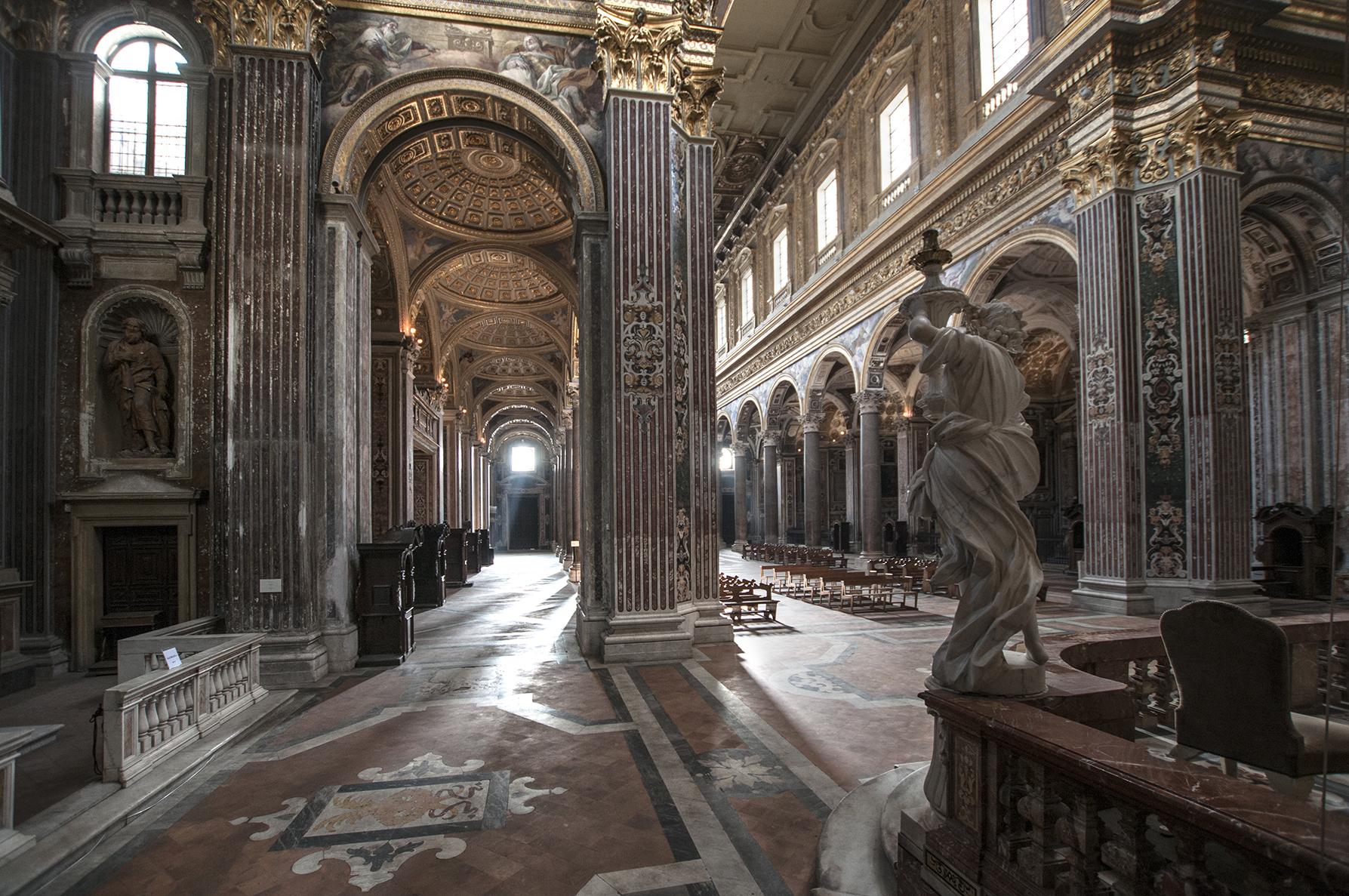 Naples is the seat of the Roman Catholic Archdiocese of Naples, Archdiocese of Naples; there are hundreds of churches in the city. The Naples Cathedral, Cathedral of Naples is the city's premier place of worship; each year on 19 September, it hosts the longstanding Miracle of Januarius, Saint Januarius, the city's patron saint. During the miracle, which thousands of Neapolitans flock to witness, the dried blood of Januarius is said to turn to liquid when brought close to holy relics said to be of his body. Below is a selective list of Naples' major churches, chapels, and monastery complexes:
* Certosa di San Martino
* Naples Cathedral
* San Francesco di Paola (Naples), San Francesco di Paola
* Gesù Nuovo
* Girolamini, Naples, Girolamini
* San Domenico Maggiore
* Santa Chiara (Naples), Santa Chiara
* San Paolo Maggiore
* Santa Maria della Sanità, Naples
* Santa Maria del Carmine (Naples), Santa Maria del Carmine
* Sant'Agostino alla Zecca
* Madre del Buon Consiglio
* Santa Donna Regina Nuova, Santa Maria Donna Regina Nuova
* San Lorenzo Maggiore, Naples, San Lorenzo Maggiore
* Santa Maria Donna Regina Vecchia
* Santa Caterina a Formiello
* Santissima Annunziata Maggiore, Naples, Santissima Annunziata Maggiore
* San Gregorio Armeno
* San Giovanni a Carbonara
* Santa Maria La Nova
* Sant'Anna dei Lombardi
* Sant'Eligio Maggiore
* Santa Restituta
* Cappella Sansevero, Sansevero Chapel
* San Pietro a Maiella
* San Gennaro extra Moenia
* San Ferdinando (Naples), San Ferdinando
* Pio Monte della Misericordia
* Santa Maria di Montesanto, Naples, Santa Maria di Montesanto
* Chiesa di Sant'Antonio Abate, Sant'Antonio Abate
* Santa Caterina a Chiaia
* San Pietro Martire (Naples), San Pietro Martire
* Hermitage of Camaldoli (Naples), Hermitage of Camaldoli
* Archbishop's Palace (Naples), Archbishop's Palace
Naples is the seat of the Roman Catholic Archdiocese of Naples, Archdiocese of Naples; there are hundreds of churches in the city. The Naples Cathedral, Cathedral of Naples is the city's premier place of worship; each year on 19 September, it hosts the longstanding Miracle of Januarius, Saint Januarius, the city's patron saint. During the miracle, which thousands of Neapolitans flock to witness, the dried blood of Januarius is said to turn to liquid when brought close to holy relics said to be of his body. Below is a selective list of Naples' major churches, chapels, and monastery complexes:
* Certosa di San Martino
* Naples Cathedral
* San Francesco di Paola (Naples), San Francesco di Paola
* Gesù Nuovo
* Girolamini, Naples, Girolamini
* San Domenico Maggiore
* Santa Chiara (Naples), Santa Chiara
* San Paolo Maggiore
* Santa Maria della Sanità, Naples
* Santa Maria del Carmine (Naples), Santa Maria del Carmine
* Sant'Agostino alla Zecca
* Madre del Buon Consiglio
* Santa Donna Regina Nuova, Santa Maria Donna Regina Nuova
* San Lorenzo Maggiore, Naples, San Lorenzo Maggiore
* Santa Maria Donna Regina Vecchia
* Santa Caterina a Formiello
* Santissima Annunziata Maggiore, Naples, Santissima Annunziata Maggiore
* San Gregorio Armeno
* San Giovanni a Carbonara
* Santa Maria La Nova
* Sant'Anna dei Lombardi
* Sant'Eligio Maggiore
* Santa Restituta
* Cappella Sansevero, Sansevero Chapel
* San Pietro a Maiella
* San Gennaro extra Moenia
* San Ferdinando (Naples), San Ferdinando
* Pio Monte della Misericordia
* Santa Maria di Montesanto, Naples, Santa Maria di Montesanto
* Chiesa di Sant'Antonio Abate, Sant'Antonio Abate
* Santa Caterina a Chiaia
* San Pietro Martire (Naples), San Pietro Martire
* Hermitage of Camaldoli (Naples), Hermitage of Camaldoli
* Archbishop's Palace (Naples), Archbishop's Palace
Other features
Aside from the Piazza del Plebiscito, Naples has two other major public squares: the Piazza Dante (Naples), Piazza Dante and the Piazza dei Martiri. The latter originally had only a memorial to religious martyrs, but in 1866, after the Italian unification, four lions were added, representing the four rebellions against the Bourbons. The San Gennaro dei Poveri is a Renaissance-era hospital for the poor, erected by the Spanish in 1667. It was the forerunner of a much more ambitious project, the Ospedale L'Albergo Reale dei Poveri, Naples, Bourbon Hospice for the Poor started by Charles III of Spain, Charles III. This was for the destitute and ill of the city; it also provided a self-sufficient community where the poor would live and work. Though a notable landmark, it is no longer a functioning hospital.Subterranean Naples
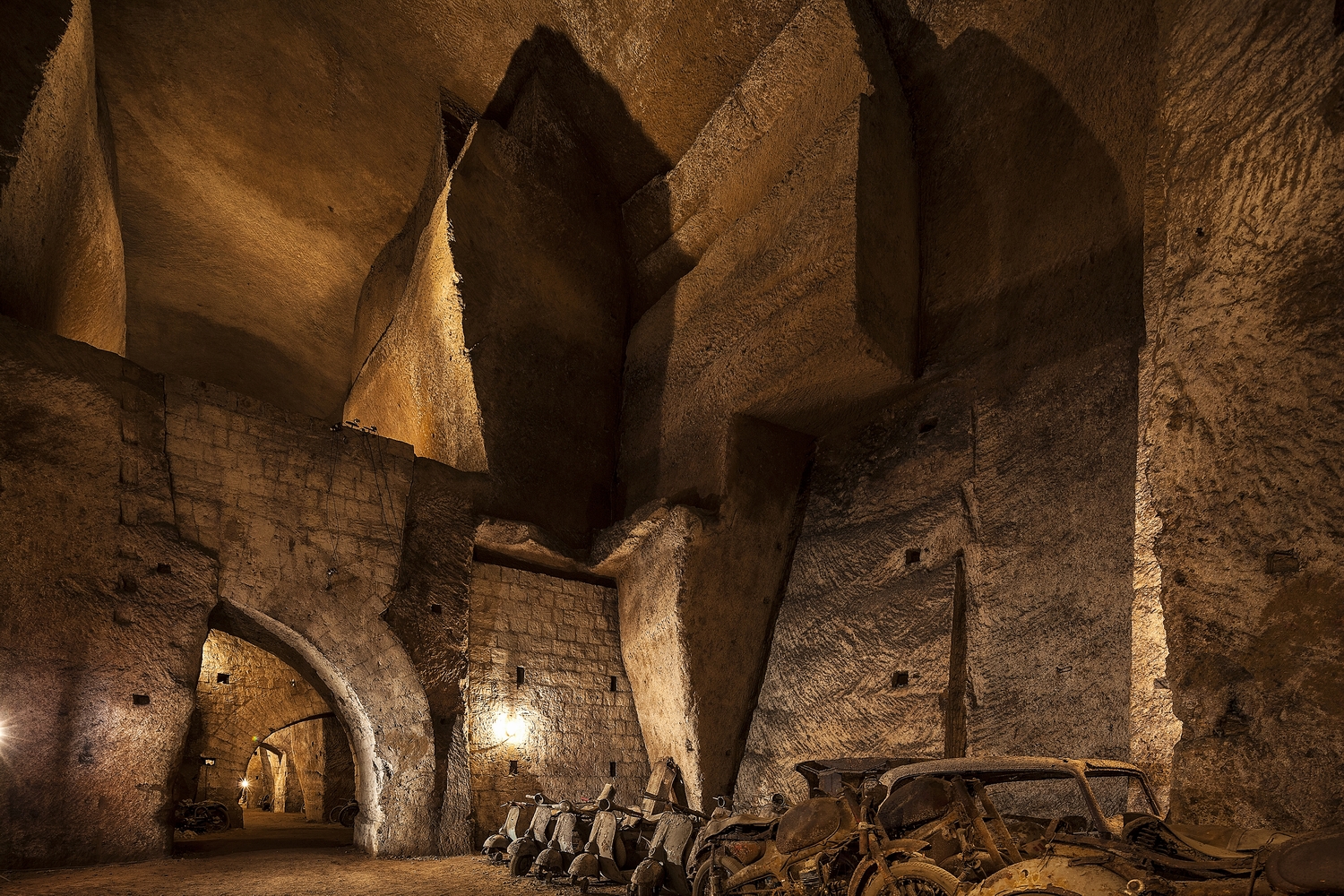 Naples underground geothermal zone, Underneath Naples lies a series of caves and structures created by centuries of mining, and the city rests atop a major geothermal (geology), geothermal zone. There are also several ancient Greco-Roman reservoirs dug out from the soft tuff, tufo stone on which, and from which, much of the city is built. Approximately of the many kilometres of tunnels under the city can be visited from the Naples underground geothermal zone, Napoli Sotteranea, situated in the historic centre of the city in Via dei Tribunali (Naples), Via dei Tribunali. This system of tunnels and cisterns underlies most of the city and lies approximately below ground level. During
Naples underground geothermal zone, Underneath Naples lies a series of caves and structures created by centuries of mining, and the city rests atop a major geothermal (geology), geothermal zone. There are also several ancient Greco-Roman reservoirs dug out from the soft tuff, tufo stone on which, and from which, much of the city is built. Approximately of the many kilometres of tunnels under the city can be visited from the Naples underground geothermal zone, Napoli Sotteranea, situated in the historic centre of the city in Via dei Tribunali (Naples), Via dei Tribunali. This system of tunnels and cisterns underlies most of the city and lies approximately below ground level. During Parks, gardens, villas, fountains and stairways
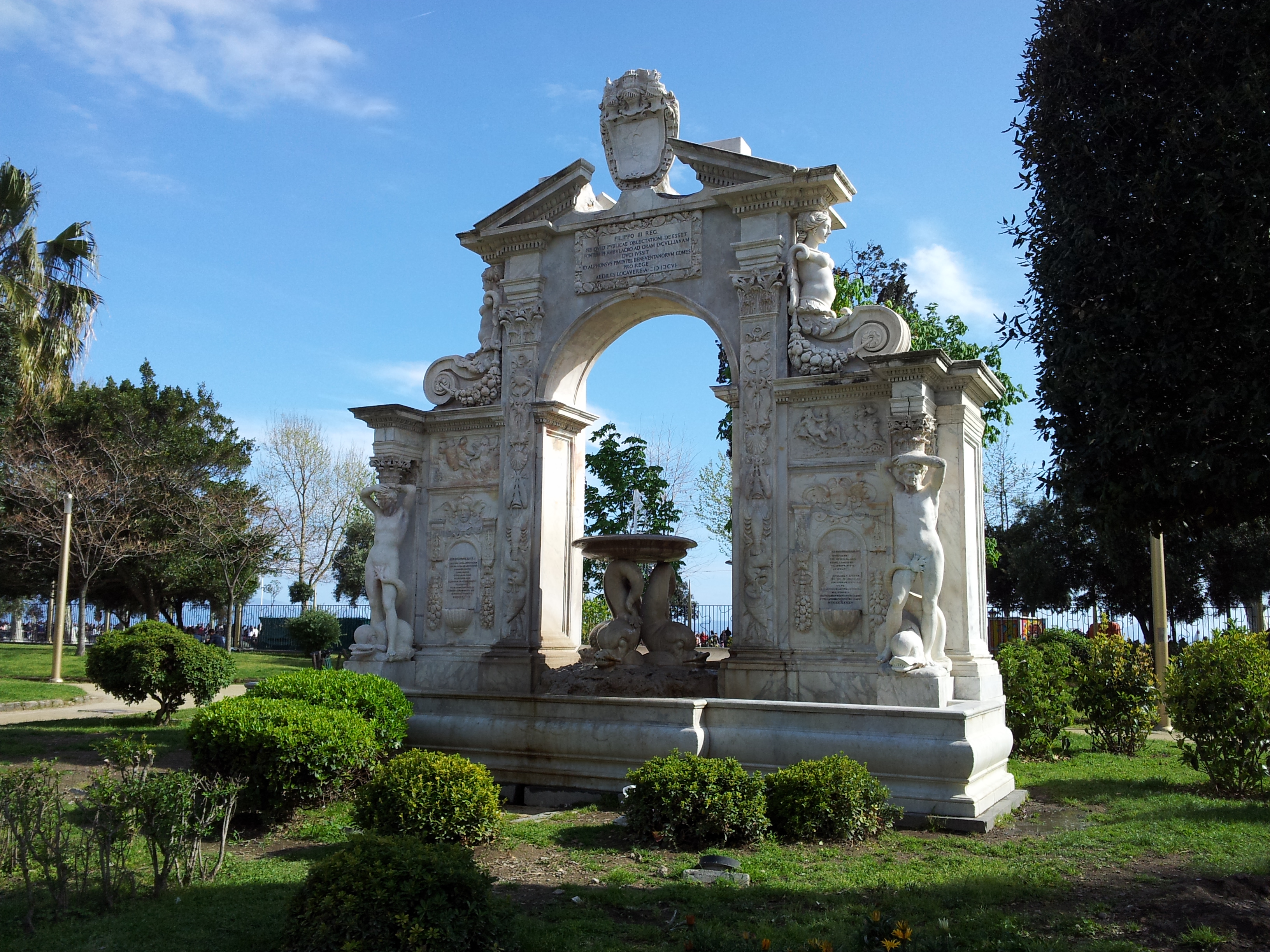 Of the various park, public parks in Naples, the most prominent are the Villa Comunale, which was built by the Bourbon king Ferdinand I of the Two Sicilies, Ferdinand IV in the 1780s; the park was originally a "Royal Garden", reserved for members of the royal family, but open to the public on special holidays. The Bosco di Capodimonte, the city's largest green space, served as a royal hunting reserve. The Park has 16 additional historical buildings, including residences, lodges, churches, fountains, statues, orchards and woods.
Another important park is the Parco Virgiliano, which looks towards the tiny volcanic islet of
Of the various park, public parks in Naples, the most prominent are the Villa Comunale, which was built by the Bourbon king Ferdinand I of the Two Sicilies, Ferdinand IV in the 1780s; the park was originally a "Royal Garden", reserved for members of the royal family, but open to the public on special holidays. The Bosco di Capodimonte, the city's largest green space, served as a royal hunting reserve. The Park has 16 additional historical buildings, including residences, lodges, churches, fountains, statues, orchards and woods.
Another important park is the Parco Virgiliano, which looks towards the tiny volcanic islet of Neo-Gothic, ''Liberty Napoletano'' and modern architecture

 Various buildings inspired by the Gothic Revival Architecture, Gothic Revival are extant in Naples, due to the influence that this movement had on the Scottish-Indian architect Lamont Young (Naples), Lamont Young, one of the most active Neapolitan architects of the late 19th and early 20th centuries. Young left a significant footprint in the cityscape and designed many urban projects, such as the city's first subway.
In the first years of the 20th century, a local version of the Art Nouveau phenomenon, known as "Liberty Napoletano", developed in the city, creating many buildings which still stand today. In 1935, the Rationalist architect Luigi Cosenza designed a new fish market for the city. During the Benito Mussolini era, the first structures of the city's "service center" were built, all in a Rationalist-Functionalist style, including the Palazzo delle Poste and the Pretura buildings. The Centro Direzionale (Naples), Centro Direzionale di Napoli is the only adjacent cluster of skyscrapers in southern Europe.
Various buildings inspired by the Gothic Revival Architecture, Gothic Revival are extant in Naples, due to the influence that this movement had on the Scottish-Indian architect Lamont Young (Naples), Lamont Young, one of the most active Neapolitan architects of the late 19th and early 20th centuries. Young left a significant footprint in the cityscape and designed many urban projects, such as the city's first subway.
In the first years of the 20th century, a local version of the Art Nouveau phenomenon, known as "Liberty Napoletano", developed in the city, creating many buildings which still stand today. In 1935, the Rationalist architect Luigi Cosenza designed a new fish market for the city. During the Benito Mussolini era, the first structures of the city's "service center" were built, all in a Rationalist-Functionalist style, including the Palazzo delle Poste and the Pretura buildings. The Centro Direzionale (Naples), Centro Direzionale di Napoli is the only adjacent cluster of skyscrapers in southern Europe.
Geography
 The city is situated on the Gulf of Naples, on the western coast of southern Italy; it rises from sea level to an elevation of . The small rivers that formerly crossed the city's centre have since been covered by construction. It lies between two notable volcanic regions, Mount Vesuvius and the Campi Flegrei ( en, Phlegraean Fields). The islands of Procida, Capri and Ischia can all be reached from Naples by hydrofoils and ferries. Sorrento, Italy, Sorrento and the Amalfi Coast are situated south of the city. At the same time, the Roman ruins of Pompeii, Herculaneum, Oplontis and Stabiae, which were destroyed in the eruption of Vesuvius in 79 AD, are also visible nearby. The port towns of Pozzuoli and Baiae, Baia, which were part of the Roman naval facility of Portus Julius, lie to the west of the city.
The city is situated on the Gulf of Naples, on the western coast of southern Italy; it rises from sea level to an elevation of . The small rivers that formerly crossed the city's centre have since been covered by construction. It lies between two notable volcanic regions, Mount Vesuvius and the Campi Flegrei ( en, Phlegraean Fields). The islands of Procida, Capri and Ischia can all be reached from Naples by hydrofoils and ferries. Sorrento, Italy, Sorrento and the Amalfi Coast are situated south of the city. At the same time, the Roman ruins of Pompeii, Herculaneum, Oplontis and Stabiae, which were destroyed in the eruption of Vesuvius in 79 AD, are also visible nearby. The port towns of Pozzuoli and Baiae, Baia, which were part of the Roman naval facility of Portus Julius, lie to the west of the city.
Quarters
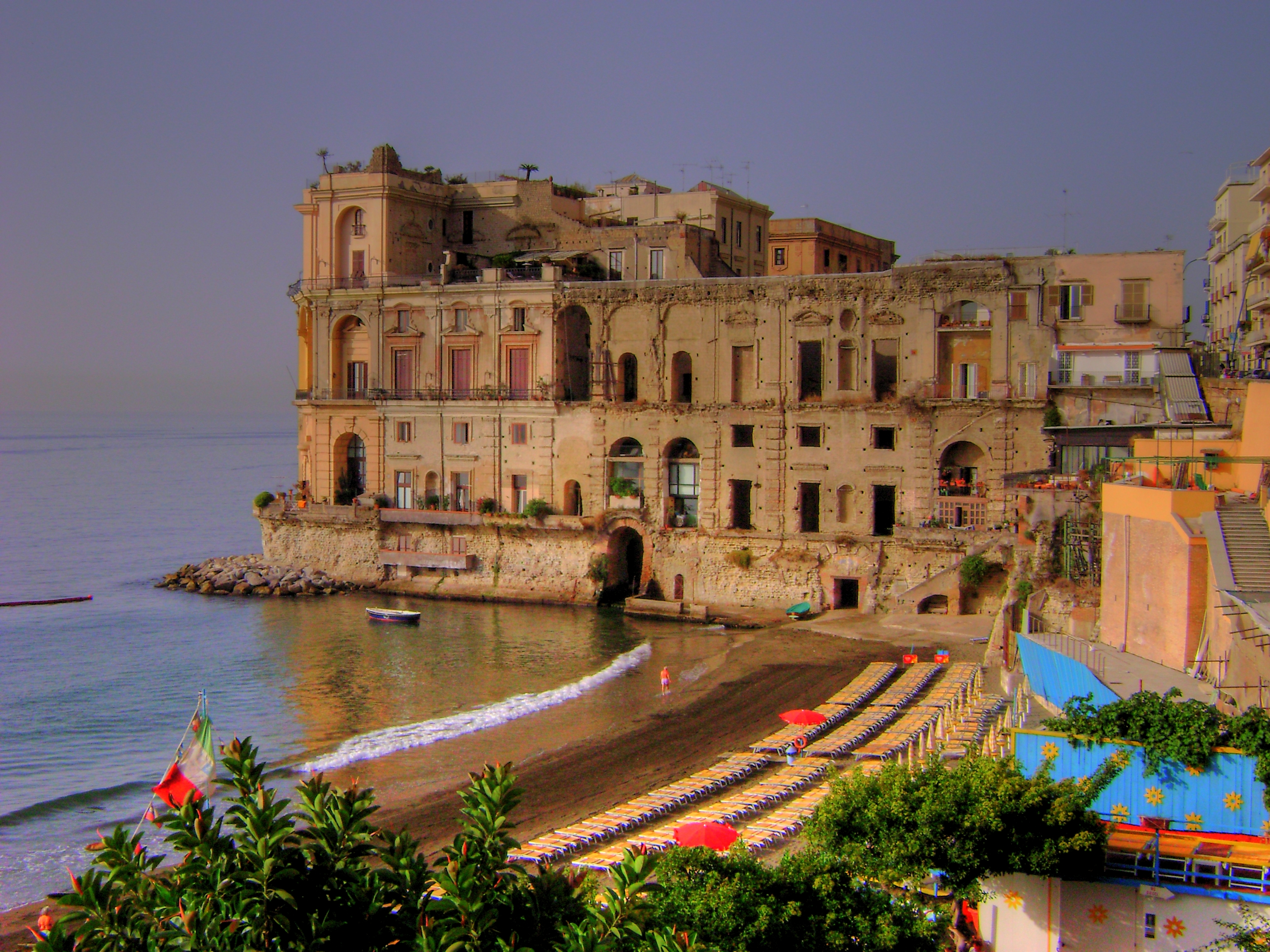 The thirty quarters (''quartiere, quartieri'') of Naples are listed below. For administrative purposes, these thirty districts are grouped together into ten governmental community boards.
The thirty quarters (''quartiere, quartieri'') of Naples are listed below. For administrative purposes, these thirty districts are grouped together into ten governmental community boards.
Climate
Naples has a Mediterranean climate (''Csa'') in the Köppen climate classification. The climate and fertility of the Gulf of Naples made the region famous during Roman times, when emperors such as Claudius and Tiberius holidayed near the city. The climate is a crossover between maritime and continental features, as typical of peninsular Italy. Maritime features mitigate the winters but occasionally cause heavy rainfall, particularly in the autumn and winter. Summers feature high temperatures and humidity. The continental influence still ensures summer highs averaging near , and Naples falls within the subtropical climate range with summer daily-mean above with hot days, warm nights and occasional summer thunderstorms. Winters are mild, and snow is rare in the city area but frequent on Mount Vesuvius. November is the wettest month in Naples, while July is the driest.Demographics
 , the population of the ''comune di Napoli'' totals around 910,000. Naples' wider Naples metropolitan area, metropolitan area, sometimes known as Greater Naples, has a population of approximately 4.4 million. The demographic profile for the Neapolitan province in general is relatively young: 19% are under the age of 14, while 13% are over 65, compared to the national average of 14% and 19%, respectively. Naples has a higher percentage of females (52.5%) than males (47.5%).‘City’ population (i.e. that of the ''comune'' or municipality)
, the population of the ''comune di Napoli'' totals around 910,000. Naples' wider Naples metropolitan area, metropolitan area, sometimes known as Greater Naples, has a population of approximately 4.4 million. The demographic profile for the Neapolitan province in general is relatively young: 19% are under the age of 14, while 13% are over 65, compared to the national average of 14% and 19%, respectively. Naples has a higher percentage of females (52.5%) than males (47.5%).‘City’ population (i.e. that of the ''comune'' or municipality)City of Naples
. Comuni-italiani.it. 2012. Retrieved 11 April 2012. Naples currently has a higher birth rate than other parts of Italy, with 10.46 births per 1,000 inhabitants, compared to the Italian average of 9.45 births. Naples's population rose from 621,000 in 1901 to 1,226,000 in 1971, declining to 910,000 in 2022 as city dwellers moved to the suburbs. According to different sources, Naples' Naples metropolitan area, metropolitan area is either the List of cities in Italy by population, second-most-populated metropolitan area in Italy after
Education
Naples is noted for its numerous higher education institutes and research centres. Naples hosts what is thought to be the oldest state university in the world, in the form of the University of Naples Federico II, which was founded by Frederick II, Holy Roman Emperor, Frederick II in 1224. The university is among the most prominent in Italy, with around 100,000 students and over 3,000 professors in 2007. It is host to the Botanical Garden of Naples, which was opened in 1807 by Joseph Bonaparte, using plans drawn up under the Bourbon king Ferdinand I of the Two Sicilies, Ferdinand IV. The garden's 15 hectares feature around 25,000 samples of over 10,000 species. Naples is also served by the "Università degli Studi della Campania Luigi Vanvitelli, Second University" (today named Università degli Studi della Campania Luigi Vanvitelli, University of Campania Luigi Vanvitelli), a modern university which opened in 1989, and which has strong links to the nearby province of Caserta. Another notable centre of education is the Naples Eastern University, Istituto Universitario Orientale, which specialises in Eastern world, Eastern culture, and was founded by the Society of Jesus, Jesuit missionary Matteo Ripa in 1732, after he returned from the court of Kangxi Emperor, Kangxi, the Emperor of China, Emperor of the Manchu people, Manchu Qing Dynasty of China. Other prominent universities in Naples include the Parthenope University of Naples, the private Suor Orsola Benincasa University of Naples, Istituto Universitario Suor Orsola Benincasa, and the Society of Jesus, Jesuit San Luigi Papal Theological Seminary of Southern Italy, Theological Seminary of Southern Italy. The Music conservatories of Naples, San Pietro a Maiella music conservatory is the city's foremost institution of musical education; the earliest Neapolitan music conservatories were founded in the 16th century under the Spanish. The Accademia di Belle Arti di Napoli, Academy of Fine Arts located on the Via Santa Maria di Costantinopoli is the city's foremost art school and one of the oldest in Italy. Naples hosts also the Astronomical Observatory of Capodimonte, established in 1812 by the king Joachim Murat and the astronomer Federigo Zuccari, the oldest marine zoology, marine zoological study station in the world, Stazione Zoologica Anton Dohrn, created in 1872 by German scientist Anton Dohrn, and the world's oldest permanent volcano observatory, the Vesuvius Observatory, founded in 1841. The Observatory lies on the slopes of Mount Vesuvius, near the city of Ercolano, and is now a permanent specialised institute of the :it:Istituto Nazionale di Geofisica e Vulcanologia, Italian National Institute of Geophysics.Politics


Governance
Each of the 7,904 ''comune'' in Italy is today represented locally by a city council headed by an elected mayor, known as a ''sindaco'' and informally called the first citizen (''primo cittadino''). This system, or one very similar to it, has been in place since the invasion of Italy by Napoleon I of France, Napoleonic forces in 1808. When the Kingdom of the Two Sicilies was restored, the system was kept in place with members of the nobility filling mayoral roles. By the end of the 19th century, political party, party politics had begun to emerge; during the Italian Fascism, fascist era, each commune was represented by a ''podestà''. SinceAdministrative subdivisions
Economy

 Naples, within its administrative limits, is Italy's fourth-largest economy after
Naples, within its administrative limits, is Italy's fourth-largest economy after PricewaterhouseCoopers. November 2009. Retrieved 23 April 2012. Naples is a major Container terminal, cargo terminal, and the port of Naples is one of the Mediterranean's largest and busiest. The city has experienced significant economic growth since World War II, but joblessness remains a major problem, and the city is characterised by high levels of political corruption and organised crime, as well as in other cities of the country. Naples is a major national, and international tourist destination, one of Italy's and Europe's top tourist cities. Tourists began visiting Naples in the 18th century during the Grand Tour. In the last decades, there has been a move away from a traditional agriculture-based economy in the province of Naples to one based on Tertiary sector of the economy, service industries. The service sector employs the majority of Neapolitans, although more than half of these are small enterprises with fewer than 20 workers; about 70 companies are said to be medium-sized with more than 200 workers, and about 15 have more than 500 workers.
Tourism
Naples is, with Florence,Transport

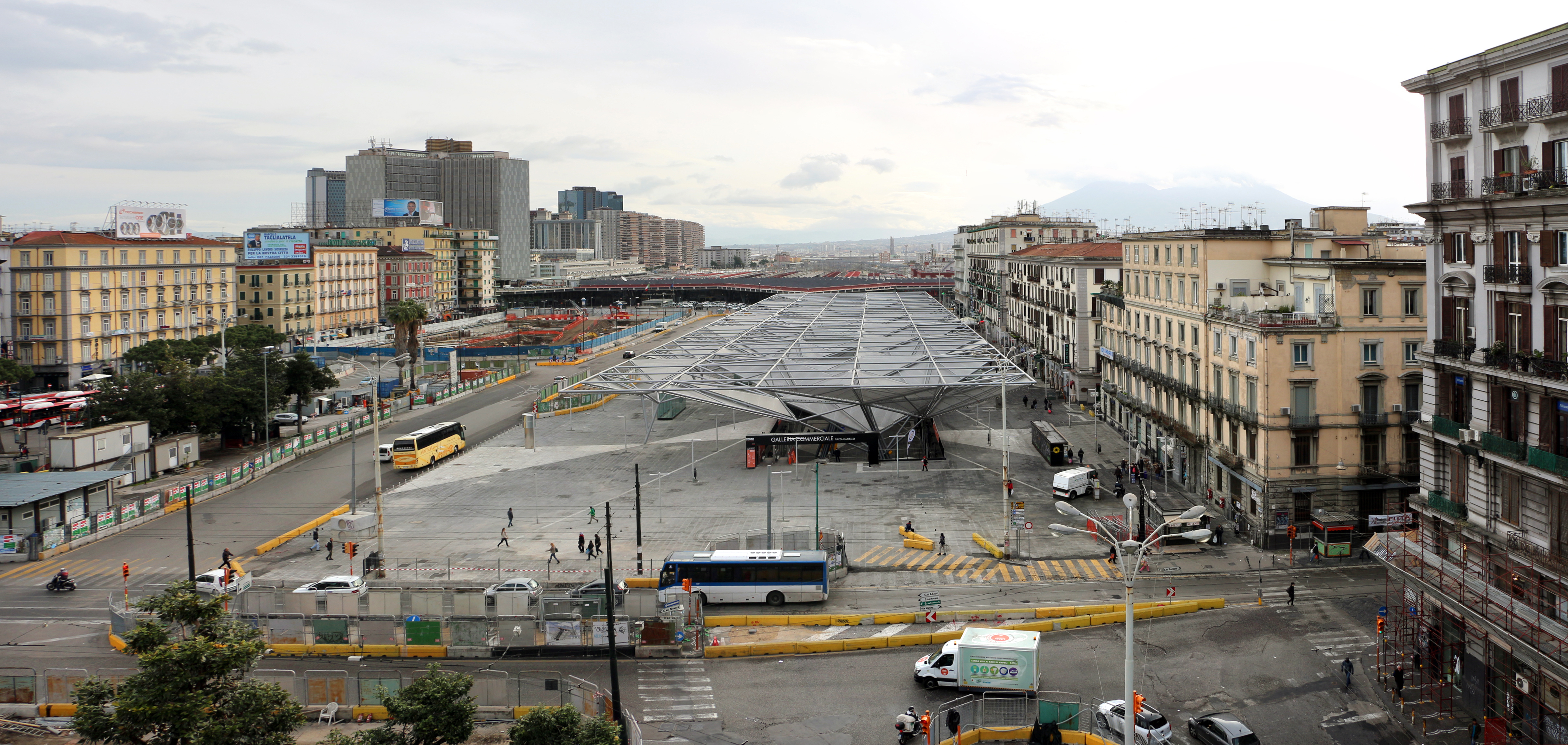
 Naples is served by several major motorways (Italian language, it: ''autostrade''). The Autostrada A1 (Italy), Autostrada A1, the longest Autostrade of Italy, motorway in Italy, links Naples to
Naples is served by several major motorways (Italian language, it: ''autostrade''). The Autostrada A1 (Italy), Autostrada A1, the longest Autostrade of Italy, motorway in Italy, links Naples to Urban public transport
Naples has an extensive public transport network, including Trams in Naples, trams, buses and trolleybuses, most of which are operated by the municipally owned company ANM (Naples), Azienda Napoletana Mobilità (ANM). The city furthermore operates the ''Metropolitana di Napoli'', the Naples Metro, an underground rapid transit rail transport, railway system which integrates both surface railway lines and the city's List of Naples metro stations, metro stations, Art Stations of the Naples Metro, many of which are noted for their decorative architecture and public art. In fact, the station of Via Toledo is often in the top spots of the rankings of the most beautiful metro stations in the world. There are also four funiculars in the city (operated by ANM): Central Funicular, ''Centrale'', Chiaia Funicular, ''Chiaia'', Montesanto Funicular, ''Montesanto'' and Mergellina Funicular, ''Mergellina''. Four public elevators are in operation in the city: within the bridge of Chiaia, in via Acton, near the Sanità Bridge, and in the Ventaglieri Park, accompanied by two public escalators.Culture
Art
Cuisine

 Naples is internationally famous for its Neapolitan cuisine, cuisine and wine; it draws culinary influences from the numerous cultures which have inhabited it throughout its history, including the Ancient Greece, Greeks, Spanish and French. Neapolitan cuisine emerged as a distinct form in the 18th century. The ingredients are typically rich in taste while remaining affordable to the general populace.
Naples is traditionally credited as the home of pizza. This originated as a meal of the poor, but under Ferdinand I of the Two Sicilies, Ferdinand IV it became popular among the upper classes: famously, the Margherita (pizza), Margherita pizza was named after Queen Margherita of Savoy after her visit to the city. Cooked traditionally in a wood-burning Masonry oven, oven, the ingredients of Neapolitan pizza have been strictly regulated by law since 2004, and must include wheat flour type "00" with the addition of flour type "0" yeast, natural mineral water, peeled tomatoes or fresh cherry tomatoes, mozzarella, sea salt and extra virgin olive oil."Proposal of recognition of the Specialita' Traditionale Garantita 'Pizza Napoletana'"
Naples is internationally famous for its Neapolitan cuisine, cuisine and wine; it draws culinary influences from the numerous cultures which have inhabited it throughout its history, including the Ancient Greece, Greeks, Spanish and French. Neapolitan cuisine emerged as a distinct form in the 18th century. The ingredients are typically rich in taste while remaining affordable to the general populace.
Naples is traditionally credited as the home of pizza. This originated as a meal of the poor, but under Ferdinand I of the Two Sicilies, Ferdinand IV it became popular among the upper classes: famously, the Margherita (pizza), Margherita pizza was named after Queen Margherita of Savoy after her visit to the city. Cooked traditionally in a wood-burning Masonry oven, oven, the ingredients of Neapolitan pizza have been strictly regulated by law since 2004, and must include wheat flour type "00" with the addition of flour type "0" yeast, natural mineral water, peeled tomatoes or fresh cherry tomatoes, mozzarella, sea salt and extra virgin olive oil."Proposal of recognition of the Specialita' Traditionale Garantita 'Pizza Napoletana'". Forno Bravo. 24 May 2004. Retrieved 27 November 2011. Spaghetti is also associated with the city and is commonly eaten with clams ''vongole or lupini di mare'': a popular Neapolitan folklore, folkloric symbol is the comic figure Pulcinella eating a plate of spaghetti. Other dishes popular in Naples include ''Parmigiana di melanzane'', ''spaghetti alle vongole'' and ''casatiello''. As a coastal city, Naples is furthermore known for numerous seafood dishes, including ''impepata di cozze'' (peppered mussels), ''purpetiello affogato'' (octopus poached in broth), ''alici marinate'' (marinated anchovies), ''baccalà alla napoletana'' (salt cod) and ''baccalà fritto'' (fried cod), a dish commonly eaten during the Christmas period. Naples is well known for its sweet dishes, including colourful gelato, which is similar to ice cream, though more fruit-based. Popular Neapolitan pastry dishes include ''zeppole'' (more commonly called "'a Pasta Cresciuta" and "'e fFritt' 'e Viento") ''Rum baba, babà'', ''sfogliatelle'' and ''pastiera'', the latter of which is prepared specially for Easter celebrations. Another seasonal sweet is ''struffoli'', a sweet-tasting honey dough decorated and eaten around Christmas. Neapolitan coffee is also widely acclaimed. The traditional Neapolitan flip coffee pot, known as the ''cuccuma'' or ''cuccumella'', was the basis for the invention of the espresso machine, and also inspired the Moka pot. Wineries in the Vesuvius area produce wines such as the ''Lacryma Christi'' ("tears of Christ") and ''Terzigno''. Naples is also the home of ''limoncello'', a popular lemon liqueur.
Festivals
The cultural significance of Naples is often represented through a series of festivals held in the city. The following is a list of several festivals that take place in Naples (note: some festivals are not held on an annual basis).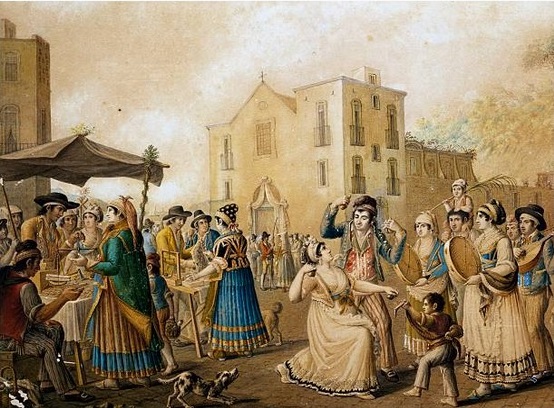 * ''Festa di Piedigrotta'' ("Piedigrotta Festival") – A musical event typically held in September in memory of the famous Madonna of Piedigrotta. Throughout the month, a series of musical workshops, concerts, religious events and children's events are held to entertain the citizens of Naples and surrounding areas.
* ''Pizzafest'' – As Naples is famous for being home to pizza, the city hosts an eleven-day festival dedicated to this iconic dish. This is a key event for Neapolitans and tourists alike, as various stations are open for tasting a wide range of true Neapolitan pizza. In addition to pizza tasting, a variety of entertainment shows are displayed.
* ''Maggio dei Monumenti'' ("May of Monuments") – A cultural event where the city hosts a variety of special events dedicated to the birth of King Charles of Bourbon. It festival features art and music of the 18th century, and many buildings which may normally be closed throughout the year are opened for visitors to view.
* ''Il Ritorno della festa di San Gennaro'' ("The Return of the Feast of San Gennaro") – An annual celebration and feast of faith held over three days, commemorating Saint Januarius, Gennaro. Throughout the festival, parades, religious processions and musical entertainment are featured. An annual celebration is also held in "Little Italy, Manhattan, Little Italy" in Manhattan.
* ''Festa di Piedigrotta'' ("Piedigrotta Festival") – A musical event typically held in September in memory of the famous Madonna of Piedigrotta. Throughout the month, a series of musical workshops, concerts, religious events and children's events are held to entertain the citizens of Naples and surrounding areas.
* ''Pizzafest'' – As Naples is famous for being home to pizza, the city hosts an eleven-day festival dedicated to this iconic dish. This is a key event for Neapolitans and tourists alike, as various stations are open for tasting a wide range of true Neapolitan pizza. In addition to pizza tasting, a variety of entertainment shows are displayed.
* ''Maggio dei Monumenti'' ("May of Monuments") – A cultural event where the city hosts a variety of special events dedicated to the birth of King Charles of Bourbon. It festival features art and music of the 18th century, and many buildings which may normally be closed throughout the year are opened for visitors to view.
* ''Il Ritorno della festa di San Gennaro'' ("The Return of the Feast of San Gennaro") – An annual celebration and feast of faith held over three days, commemorating Saint Januarius, Gennaro. Throughout the festival, parades, religious processions and musical entertainment are featured. An annual celebration is also held in "Little Italy, Manhattan, Little Italy" in Manhattan.
Language
The Naples language, considered to be a distinct language and mainly spoken in the city, is also found in the region ofLiterature and philosophy
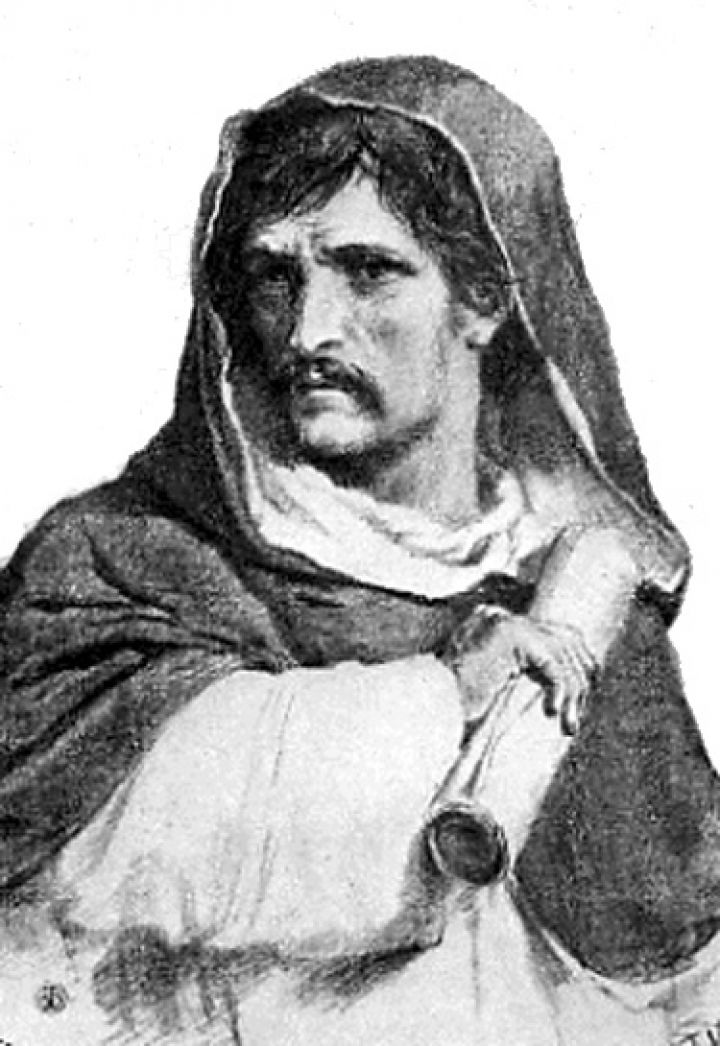 Naples is one of the leading centres of Italian literature. The history of the Neapolitan language was deeply entwined with that of the Tuscan dialect, which then became the current Italian language. The first written testimonies of the Italian language are the Placiti Cassinensi legal documents, dated 960 A.D., preserved in the Monte Cassino Abbey, which are, in fact, evidence of a language spoken in a southern dialect. The Tuscan poet Boccaccio lived for many years at the court of King Robert the Wise and his successor Joanna I of Naples, Joanna of Naples, using Naples as a setting for ''The Decameron'' and a number of his later novels. His works contain some words that are taken from Neapolitan instead of the corresponding Italian, e.g. "testo" (neap.: "testa"), which in Naples indicates a large terracotta jar used to cultivate shrubs and little trees. King Alfonso V of Aragon stated in 1442 that the Neapolitan language was to be used instead of Latin in official documents.
Naples is one of the leading centres of Italian literature. The history of the Neapolitan language was deeply entwined with that of the Tuscan dialect, which then became the current Italian language. The first written testimonies of the Italian language are the Placiti Cassinensi legal documents, dated 960 A.D., preserved in the Monte Cassino Abbey, which are, in fact, evidence of a language spoken in a southern dialect. The Tuscan poet Boccaccio lived for many years at the court of King Robert the Wise and his successor Joanna I of Naples, Joanna of Naples, using Naples as a setting for ''The Decameron'' and a number of his later novels. His works contain some words that are taken from Neapolitan instead of the corresponding Italian, e.g. "testo" (neap.: "testa"), which in Naples indicates a large terracotta jar used to cultivate shrubs and little trees. King Alfonso V of Aragon stated in 1442 that the Neapolitan language was to be used instead of Latin in official documents.
Theatre
 Naples was one of the centres of the peninsula from which originated the modern theatre genre as nowadays intended, evolving from 16th century "commedia dell'arte, comedy of art".
The masked character of Pulcinella is a worldwide famous figure either as a theatrical character or puppetry character.
The music Opera genre of opera buffa was created in Naples in the 18th century and then spread to Rome and northern Italy. In the period of Belle Époque, Naples rivalled Paris for its Café-chantants, and many famous Neapolitan songs were originally created to entertain the public in the cafès of Naples. Perhaps the most well-known song is "Ninì Tirabusciò". The history of how this song was born was dramatised in the eponymous comedy movie "Ninì Tirabusciò: la donna che inventò la mossa" starring Monica Vitti.
The Neapolitan popular genre of "Sceneggiata" is an important genre of modern folk theatre worldwide, dramatising common canon themes of thwarted love stories, comedies, tearjerker stories, commonly about honest people becoming camorra outlaws due to unfortunate events. The Sceneggiata became very popular amongst Neapolitans and eventually one of the best-known genres of Italian cinematography thanks to actors and singers like Mario Merola (singer), Mario Merola and Nino D'Angelo. Many writers and playwrights, such as Raffaele Viviani, wrote comedies and dramas for this genre. Actors and comedians like Eduardo Scarpetta and then his sons Eduardo De Filippo, Peppino De Filippo and Titina De Filippo contributed to making the Neapolitan theatre. Its comedies and tragedies, such as "Filumena Marturano" and "Side Street Story, Napoli Milionaria", are well-known.
Naples was one of the centres of the peninsula from which originated the modern theatre genre as nowadays intended, evolving from 16th century "commedia dell'arte, comedy of art".
The masked character of Pulcinella is a worldwide famous figure either as a theatrical character or puppetry character.
The music Opera genre of opera buffa was created in Naples in the 18th century and then spread to Rome and northern Italy. In the period of Belle Époque, Naples rivalled Paris for its Café-chantants, and many famous Neapolitan songs were originally created to entertain the public in the cafès of Naples. Perhaps the most well-known song is "Ninì Tirabusciò". The history of how this song was born was dramatised in the eponymous comedy movie "Ninì Tirabusciò: la donna che inventò la mossa" starring Monica Vitti.
The Neapolitan popular genre of "Sceneggiata" is an important genre of modern folk theatre worldwide, dramatising common canon themes of thwarted love stories, comedies, tearjerker stories, commonly about honest people becoming camorra outlaws due to unfortunate events. The Sceneggiata became very popular amongst Neapolitans and eventually one of the best-known genres of Italian cinematography thanks to actors and singers like Mario Merola (singer), Mario Merola and Nino D'Angelo. Many writers and playwrights, such as Raffaele Viviani, wrote comedies and dramas for this genre. Actors and comedians like Eduardo Scarpetta and then his sons Eduardo De Filippo, Peppino De Filippo and Titina De Filippo contributed to making the Neapolitan theatre. Its comedies and tragedies, such as "Filumena Marturano" and "Side Street Story, Napoli Milionaria", are well-known.
Music
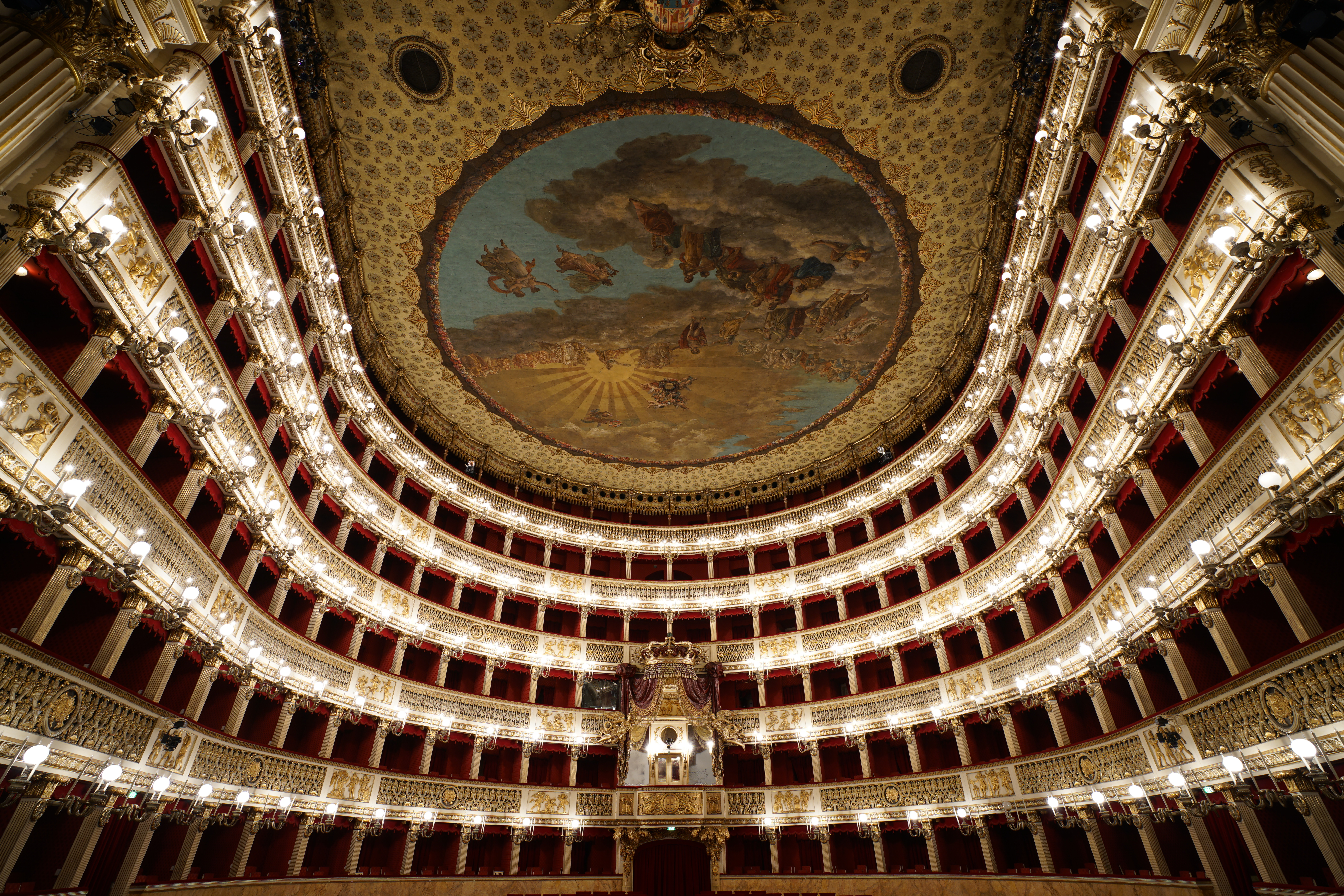 Naples has played an important role in the history of Classical music, Western European art music for more than four centuries. The first music conservatories of Naples, music conservatories were established in the city under Spanish rule in the 16th century. The San Pietro a Majella music conservatory, founded in 1826 by Francis I of the Two Sicilies, Francesco I of Bourbon, continues to operate today as both a prestigious centre of musical education and a musical museum.
During the late Baroque music, Baroque period, Alessandro Scarlatti, the father of Domenico Scarlatti, established the Neapolitan school of opera; this was in the form of ''opera seria'', which was a new development for its time. Another form of opera originating in Naples is ''opera buffa'', a style of comic opera strongly linked to Giovanni Battista Pergolesi, Battista Pergolesi and Niccolò Piccinni, Piccinni; later contributors to the genre included Gioachino Rossini, Rossini and Wolfgang Amadeus Mozart. The Teatro di San Carlo, built in 1737, is the oldest working theatre in Europe, and remains the operatic centre of Naples.
Naples has played an important role in the history of Classical music, Western European art music for more than four centuries. The first music conservatories of Naples, music conservatories were established in the city under Spanish rule in the 16th century. The San Pietro a Majella music conservatory, founded in 1826 by Francis I of the Two Sicilies, Francesco I of Bourbon, continues to operate today as both a prestigious centre of musical education and a musical museum.
During the late Baroque music, Baroque period, Alessandro Scarlatti, the father of Domenico Scarlatti, established the Neapolitan school of opera; this was in the form of ''opera seria'', which was a new development for its time. Another form of opera originating in Naples is ''opera buffa'', a style of comic opera strongly linked to Giovanni Battista Pergolesi, Battista Pergolesi and Niccolò Piccinni, Piccinni; later contributors to the genre included Gioachino Rossini, Rossini and Wolfgang Amadeus Mozart. The Teatro di San Carlo, built in 1737, is the oldest working theatre in Europe, and remains the operatic centre of Naples.

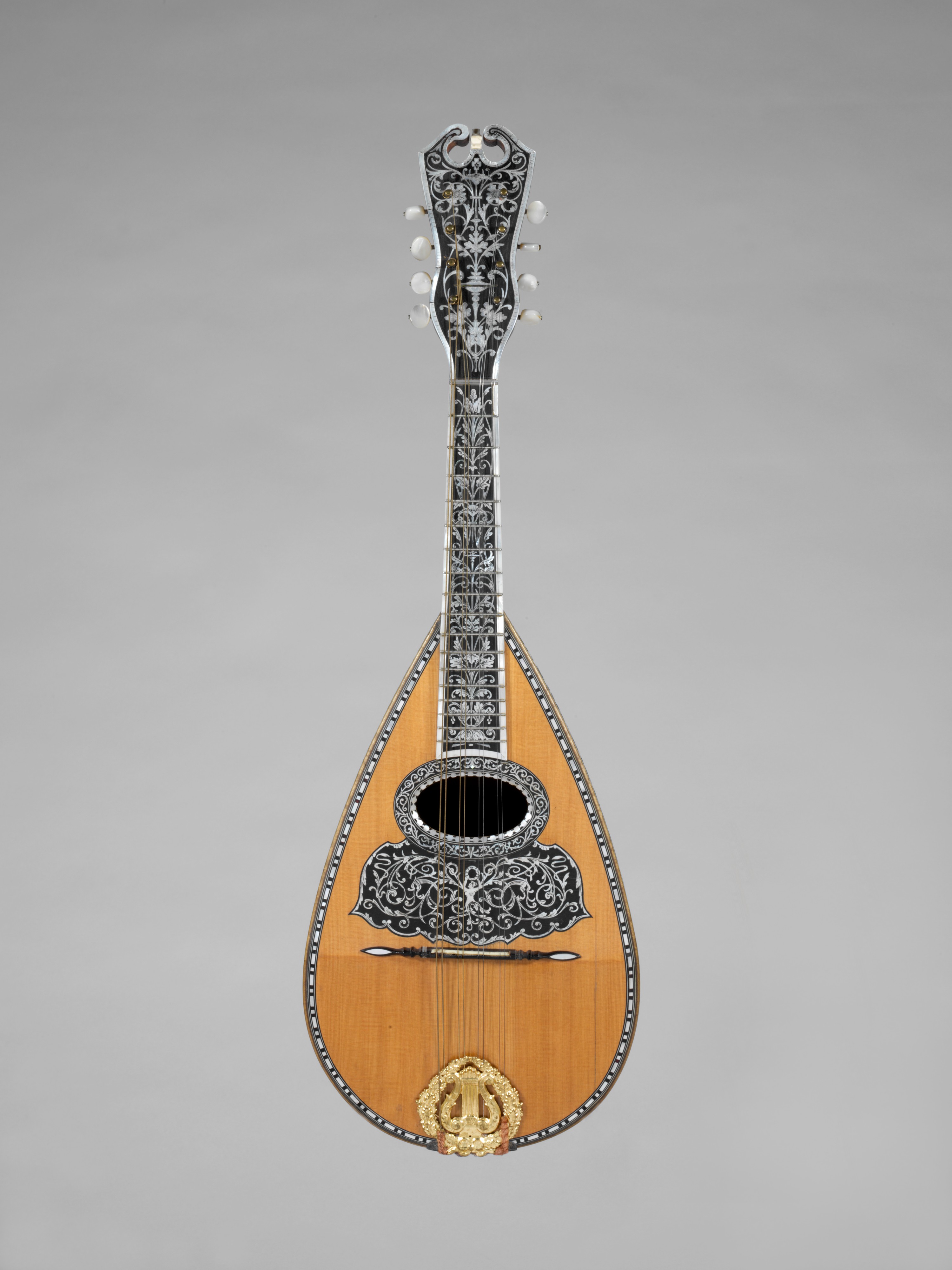 The earliest six-string guitar was created by the Neapolitan Gaetano Vinaccia in 1779; the instrument is now referred to as the romantic guitar. The Vinaccia family also developed the mandolin. Influenced by the Spanish, Neapolitans became pioneers of classical guitar music, with Ferdinando Carulli and Mauro Giuliani being prominent exponents. Giuliani, who was actually from Apulia but lived and worked in Naples, is widely considered to be one of the greatest guitarist, guitar players and composers of the 19th century, along with his Catalonia, Catalan contemporary Fernando Sor. Another Neapolitan musician of note was opera singer Enrico Caruso, one of the most prominent opera tenors of all time: he was considered a man of the people in Naples, hailing from a working-class background.
A popular traditional dance in Southern Italy and Naples is the Tarantella, which originated in Apulia and spread throughout the Kingdom of the Two Sicilies. The Neapolitan tarantella is a courtship dance performed by couples whose "rhythms, melodies, gestures, and accompanying songs are quite distinct", featuring faster, more cheerful music.
A notable element of popular Neapolitan music is the ''Canzone Napoletana'' style, essentially the traditional music of the city, with a repertoire of hundreds of folklore, folk songs, some of which can be traced back to the 13th century. The genre became a formal institution in 1835, after the introduction of the annual Festival of Piedigrotta songwriting competition. Some of the best-known recording artists in this field include Roberto Murolo, Sergio Bruni and Renato Carosone. There are furthermore various forms of music popular in Naples but not well known outside it, such as ''cantautore'' ("singer-songwriter") and ''sceneggiata'', which has been described as a musical soap opera; the most well-known exponent of this style is Mario Merola (singer), Mario Merola.
The earliest six-string guitar was created by the Neapolitan Gaetano Vinaccia in 1779; the instrument is now referred to as the romantic guitar. The Vinaccia family also developed the mandolin. Influenced by the Spanish, Neapolitans became pioneers of classical guitar music, with Ferdinando Carulli and Mauro Giuliani being prominent exponents. Giuliani, who was actually from Apulia but lived and worked in Naples, is widely considered to be one of the greatest guitarist, guitar players and composers of the 19th century, along with his Catalonia, Catalan contemporary Fernando Sor. Another Neapolitan musician of note was opera singer Enrico Caruso, one of the most prominent opera tenors of all time: he was considered a man of the people in Naples, hailing from a working-class background.
A popular traditional dance in Southern Italy and Naples is the Tarantella, which originated in Apulia and spread throughout the Kingdom of the Two Sicilies. The Neapolitan tarantella is a courtship dance performed by couples whose "rhythms, melodies, gestures, and accompanying songs are quite distinct", featuring faster, more cheerful music.
A notable element of popular Neapolitan music is the ''Canzone Napoletana'' style, essentially the traditional music of the city, with a repertoire of hundreds of folklore, folk songs, some of which can be traced back to the 13th century. The genre became a formal institution in 1835, after the introduction of the annual Festival of Piedigrotta songwriting competition. Some of the best-known recording artists in this field include Roberto Murolo, Sergio Bruni and Renato Carosone. There are furthermore various forms of music popular in Naples but not well known outside it, such as ''cantautore'' ("singer-songwriter") and ''sceneggiata'', which has been described as a musical soap opera; the most well-known exponent of this style is Mario Merola (singer), Mario Merola.
Cinema and television
 Naples has had a significant influence on Italian cinema. Because of the city's relevance, many films and television shows are set (entirely or partially) in Naples. In addition to serving as the backdrop for several movies and shows, many talented celebrities (actors, actresses, directors, and producers) are originally from Naples.
Naples was the location for several early Italian cinema masterpieces. ''Assunta Spina (1915 film), Assunta Spina'' (1915) was a silent film adapted from a theatrical drama by Neapolitan writer Salvatore Di Giacomo. The film was directed by Neapolitan Gustavo Serena. Serena also starred in the 1912 film ''Romeo and Juliet''.
A list of some well-known films that take place (fully or partially) in Naples includes:
* ''Shoeshine (film), Shoeshine'' (1946), directed by Neapolitan, Vittorio De Sica
* ''Hands over the City'' (1963), directed by Neapolitan, Francesco Rosi
* ''Journey to Italy'' (1954), directed by Roberto Rossellini
* ''Marriage Italian Style'' (1964), directed by Neapolitan, Vittorio De Sica
* ''It Started in Naples'' (1960), Directed by Melville Shavelson
* ''The Hand of God (film)'' (2021), Directed by Paolo Sorrentino
Naples is home to one of the first Italian colour films, ''Toto in Color'' (1952), starring Totò (Antonio de Curtis), a famous comedic actor born in Naples.
Some notable comedies set in Naples include ''Ieri, Oggi e Domani'' (Yesterday, Today and Tomorrow), by Vittorio De Sica, starring Sophia Loren and Marcello Mastroianni, ''Adelina of Naples'' (Academy Award-winning movie), ''It Started in Naples'', ''L'oro di Napoli'' again by Vittorio De Sica, dramatic movies like Dino Risi's ''Profumo di donna, Scent of a Woman'', war movies like ''The Four Days of Naples (film), The Four Days of Naples'' by Sardinian director Nanni Loy, music and Sceneggiata movies like ''Zappatore'', from the eponymous song by Libero Bovio, starring singer and actor Mario Merola (singer), Mario Merola, crime movies like ''Il Camorrista'' with Ben Gazzara playing the part of infamous camorra boss Raffaele Cutolo, and historical or costume movies like ''That Hamilton Woman'' starring Vivien Leigh and Laurence Olivier.
More modern Neapolitan films include ''Ricomincio da tre'', which depicts the misadventures of a young emigrant in the late 20th century. The 2008 film ''Gomorrah (film), Gomorrah'', based on the book by Roberto Saviano, explores the dark underbelly of the city of Naples through five intertwining stories about the powerful Camorra, Neapolitan crime syndicate, as well as the Gomorrah (TV series), TV series of the same name.
The Japanese series ''JoJo's Bizarre Adventure''s Part 5, Golden Wind (manga), Vento Aureo, takes place in the city.
Several episodes of the animated series ''Tom and Jerry'' also have references/influences from Naples. The song "Santa Lucia (song), Santa Lucia" played by Tom Cat in ''Cat and Dupli-cat'' has its origins in Naples. Neapolitan Mouse takes place in the same city.
Naples has appeared in episodes of TV serials such as ''The Sopranos'' and the 1998 version of ''The Count of Monte Cristo (1998 miniseries), The Count of Monte Cristo'', starring Gérard Depardieu.
Naples has had a significant influence on Italian cinema. Because of the city's relevance, many films and television shows are set (entirely or partially) in Naples. In addition to serving as the backdrop for several movies and shows, many talented celebrities (actors, actresses, directors, and producers) are originally from Naples.
Naples was the location for several early Italian cinema masterpieces. ''Assunta Spina (1915 film), Assunta Spina'' (1915) was a silent film adapted from a theatrical drama by Neapolitan writer Salvatore Di Giacomo. The film was directed by Neapolitan Gustavo Serena. Serena also starred in the 1912 film ''Romeo and Juliet''.
A list of some well-known films that take place (fully or partially) in Naples includes:
* ''Shoeshine (film), Shoeshine'' (1946), directed by Neapolitan, Vittorio De Sica
* ''Hands over the City'' (1963), directed by Neapolitan, Francesco Rosi
* ''Journey to Italy'' (1954), directed by Roberto Rossellini
* ''Marriage Italian Style'' (1964), directed by Neapolitan, Vittorio De Sica
* ''It Started in Naples'' (1960), Directed by Melville Shavelson
* ''The Hand of God (film)'' (2021), Directed by Paolo Sorrentino
Naples is home to one of the first Italian colour films, ''Toto in Color'' (1952), starring Totò (Antonio de Curtis), a famous comedic actor born in Naples.
Some notable comedies set in Naples include ''Ieri, Oggi e Domani'' (Yesterday, Today and Tomorrow), by Vittorio De Sica, starring Sophia Loren and Marcello Mastroianni, ''Adelina of Naples'' (Academy Award-winning movie), ''It Started in Naples'', ''L'oro di Napoli'' again by Vittorio De Sica, dramatic movies like Dino Risi's ''Profumo di donna, Scent of a Woman'', war movies like ''The Four Days of Naples (film), The Four Days of Naples'' by Sardinian director Nanni Loy, music and Sceneggiata movies like ''Zappatore'', from the eponymous song by Libero Bovio, starring singer and actor Mario Merola (singer), Mario Merola, crime movies like ''Il Camorrista'' with Ben Gazzara playing the part of infamous camorra boss Raffaele Cutolo, and historical or costume movies like ''That Hamilton Woman'' starring Vivien Leigh and Laurence Olivier.
More modern Neapolitan films include ''Ricomincio da tre'', which depicts the misadventures of a young emigrant in the late 20th century. The 2008 film ''Gomorrah (film), Gomorrah'', based on the book by Roberto Saviano, explores the dark underbelly of the city of Naples through five intertwining stories about the powerful Camorra, Neapolitan crime syndicate, as well as the Gomorrah (TV series), TV series of the same name.
The Japanese series ''JoJo's Bizarre Adventure''s Part 5, Golden Wind (manga), Vento Aureo, takes place in the city.
Several episodes of the animated series ''Tom and Jerry'' also have references/influences from Naples. The song "Santa Lucia (song), Santa Lucia" played by Tom Cat in ''Cat and Dupli-cat'' has its origins in Naples. Neapolitan Mouse takes place in the same city.
Naples has appeared in episodes of TV serials such as ''The Sopranos'' and the 1998 version of ''The Count of Monte Cristo (1998 miniseries), The Count of Monte Cristo'', starring Gérard Depardieu.
Sports
 Association football, Football is by far the most popular sport in Naples. Brought to the city by the British during the early 20th century, the sport is deeply embedded in local culture: it is popular at every level of society, from the ''scugnizzi'' (street children) to wealthy professionals. The city's best known football club (association football), football club is S.S.C. Napoli, SSC Napoli, which plays its home games at the Stadio San Paolo in Fuorigrotta. The club's stadium was renamed Stadio Diego Armando Maradona in honour of the Argentinian attacking midfielder who played for them for seven years. The team plays in the
Association football, Football is by far the most popular sport in Naples. Brought to the city by the British during the early 20th century, the sport is deeply embedded in local culture: it is popular at every level of society, from the ''scugnizzi'' (street children) to wealthy professionals. The city's best known football club (association football), football club is S.S.C. Napoli, SSC Napoli, which plays its home games at the Stadio San Paolo in Fuorigrotta. The club's stadium was renamed Stadio Diego Armando Maradona in honour of the Argentinian attacking midfielder who played for them for seven years. The team plays in the Tailoring
Neapolitan tailoring was born as an attempt to loosen up the stiffness of English tailoring, which didn't suit the Neapolitan lifestyle. Characteristics of Neapolitan tailoring: * The Shoulders: the Neapolitan jacket has no shoulder padding. Neapolitan tailors removed the shoulder padding from their jackets to provide more movement freedom. For this reason, the Neapolitan shoulder on informal jackets is sewn like a shirt sleeve ("spalla a camicia"), and it follows the natural curve of the human body rather than giving it shape. This type of sleeve is cut about 10 cm larger than the armhole, and it can be finished with the "repecchia" – that shirring the tailor creates with the extra fabric. This little flair is known as "manica a mappina" and gives the jacket a "rugged" appearance. For formal occasions, the Neapolitan shoulder features a "rollino" – a little roll of padding that raises the sleeve head to drape more cleanly. * The Sleeves: the Neapolitan sleeve is shorter than that found on other jackets, as Neapolitans like shirt cuffs to show right above their wrists, especially when adorned with cufflinks. The sleeves are cut closer to the arms to avoid extra fabric hanging when these are raised. * The Pockets: the pockets of a Neapolitan jackets are curved and applied as patches; the breast pocket is called "a barchetta", which means "little boat", due to the higher top corner of the pocket, which, along with the rounded bottom, gives it the shape of a stylized boat. The side pockets are equally curved, and their shape recalls that of a pot; hence the name "a pignata". Neither feature has any practical functionality, but they are particular to Neapolitan tailoring and contribute to the look of a jacket made in Naples. Double-hand finished stitching may also run throughout the sides of the patch pockets – a recurring feature in informal Neapolitan tailoring. * The Lining: lining is considered an unnecessary burden, and the Neapolitan tailors keep it as minimal as possible. Usually, the jacket is unlined or only half lined; even the sleeves are entirely unlined, as they're meant to fit closely. Additionally, the lining is often left open ("volante," literally "flying") so that people can admire the fine details and construction of the jacket. * The Lapels: Neapolitan jackets are famous for their wide lapels, which are often peaked ("a punta") for double-breasted jackets, formal jackets, and coats. The "risvolto dentellato" (the "classic" style of lapels – not peaked) is wider in Neapolitan jackets: they can be as wide as 4 inches (compared to the 3 inches of a regular lapel width). Just as is the case for the pockets, the Neapolitan lapel features double stitching running along the sides – a peculiar detail of a Neapolitan creation – although reserved for the less formal pieces. The "scollo a martiello" (literally "hammer neck") is the opening of the jacket over the shirt, which in Neapolitan tailoring is parallel to the lapels. The cran is the space that separates the lapel and the neck, and it is usually higher in Neapolitan tailoring to create the illusion of a more slender figure. * The Body: Neapolitan jackets tend to be shorter in the back; in Neapolitan dialect, they say the jacket "zompa arrèto," which roughly translates as "it jumps in the back". This characteristic allows the jacket to "slide" gracefully along the body. The vents on the sides are pretty deep in Neapolitan jackets – up to 12 inches. The Dart (sewing), darts in the front goes all the way down to help the fabric follow the shape of the body and create elegant quarters. * Buttons and Buttonholes: the three-roll-two construction features a lapel that hides the third button to provide extra freedom of movement thanks to a longer opening in the front. The buttonhole on the lapel is called "occhiello" in Italian, and it means "little eye" to its elongated almond shape. There isn't a tradition for a specific type of buttonhole in Naples, but there is a tendency of Neapolitan tailors to prefer slightly shorter and thicker buttonholes that resemble those of a shirt, while "regular" buttonholes of English tradition are more elongated and slender. Some tailors add a slight teardrop shape at the end of the buttonhole, an aesthetic choice that does not refer to a particular tradition. The buttons on the sleeves are always working and overlapping buttons.Neapolitans
Honorary citizens
People awarded honorary citizenship of Naples include:International relations
Twin towns and sister cities
Naples is town twinning, twinned with: * Gafsa, Tunisia * Kragujevac, Serbia * Palma de Mallorca, Spain * Athens, Greece * Santiago de Cuba, Cuba * Santiago de Cuba Province, Cuba * Nosy Be, Madagascar * Nablus, Palestine * Sassari, ItalyPartnerships
* Sighetu Marmației, Romania * Călărași, Romania * Budapest, Hungary * Kagoshima, Japan * Baku, Azerbaijan * Tripoli, Lebanon, Tripoli, Lebanon * Kolkata, India * Sarajevo, Bosnia and Herzegovina (since 1964)Fraternity cities on Sarajevo Official Web Site. City of Sarajevo. 2008. Retrieved 9 November 2008.
See also
* Neapolitan MastiffNotes
References
Bibliography
* Acton, Harold (1956). ''The Bourbons of Naples (1734–1825)''. London: Methuen Publishing, Methuen. * Acton, Harold (1961). ''The Last Bourbons of Naples (1825–1861)''. London: Methuen. * * Chaney, Edward (2000). "Inigo Jones in Naples" in ''The Evolution of the Grand Tour''. London: Routledge. * De Grand, Alexander J. (2001).The hunchback's tailor: Giovanni Giolitti and liberal Italy from the challenge of mass politics to the rise of fascism, 1882–1922
', Wesport/London: Praeger, * * Snowden, Frank M. (1995)
Naples in the Time of Cholera, 1884–1911
', Cambridge: Cambridge University Press,
External links
* {{Authority control Naples, Cities and towns in Campania Coastal towns in Campania Cumaean colonies Colonies of Magna Graecia Capitals of former nations Mediterranean port cities and towns in Italy Populated places established in the 7th century BC World Heritage Sites in Italy Burial sites of the House of Dampierre